 |
You know those ancient legends where people  fervently wish for something, and then up pops a genie and they wind up with far more than they can handle? fervently wish for something, and then up pops a genie and they wind up with far more than they can handle?
I once lamented that while we had fine historical CD surveys of the violin, cello, viola and even the harpsichord, sorely missing was the most popular instrument of all, the piano. Well, a genie at Philips must have heard my call. 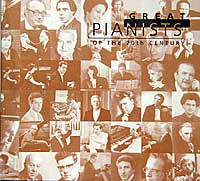 I was soon reveling in their massive "Great Pianists of the 20th Century" edition. Would you believe two hundred discs? And you thought Bear Family boxes were huge? I was soon reveling in their massive "Great Pianists of the 20th Century" edition. Would you believe two hundred discs? And you thought Bear Family boxes were huge?
Fortunately, the Edition isn't as unwieldy as it might sound. It comes in 100 mid-priced 2-CD units, each devoted to a single artist. Sheer size apart, this is a hugely impressive project. Here's the stats: 72 pianists, of whom seven giants (Arrau, Brendel, Gilels, Horowitz, Kempff, Richter and Rubinstein) are honored with three volumes each; sixteen more artists get two. (OK, wise guys - the math is correct, since two of the volumes feature pairs of pianists.) The total running time is over 250 hours, with most discs very full (some approach 81 minutes!). Much of the music is new to CD. Although Philips' own material (and that of their Decca and Deutsche Grammophon affiliates) figures prominently, recordings were licensed from the other majors (EMI, RCA and Sony) and some smaller labels as well.
Any project of this scope reflects the taste of its producer, in this case life-long piano enthusiast Tom Deacon, whose credentials and culture I wouldn't dare challenge. Even so, a few overall quibbles still seem fair, as my frustrations with this edition go beyond questions of personal taste and in fact seem fueled by the Edition's own liner notes.
While the focus is on solo work, there are also lots of concertos and other works with orchestra but nothing in between, even though the notes for many sets extol their subjects' chamber music fame. For a 20th century piano survey, there's hardly any 20th century piano music, although the notes vaunt several of the artists as committed modernists. Nor are many early masters of the century (de Greef, Lamond) or the great composer-pianists (Bartok, Prokofiev) included, presumably because they were not sufficiently prolific to fill 2 CDs by themselves, even though they are praised in their students' volumes. Even within individual sets, the notes cruelly tease with unfulfilled expectations, touting several artists' preferred repertoire which is omitted from their volumes; thus, while Leon Fleisher's unique claim to the obscure but fascinating left-hand literature is duly noted, all we get of that is his overly-familiar Ravel Concerto.
Indeed, the selections all too often seem stuck in a standard repertoire rut, with huge amounts of overlap. Among major works alone over fifty receive three or more performances. Admittedly, they're mostly masterworks and make for fascinating stylistic comparisons, but some more variety would have been nice, too. Thus, we get six versions of Prokofiev's Third Concerto, but none of Beethoven's; eight of Chopin's Second Sonata but none of Brahms's; and five of Ravel's slight Sonatina but none of his more substantial Miroirs. If you're looking to assemble a comprehensive survey of great piano music, this clearly won't do.
Rather, the organizing principle was to create musical portraits of some of the most distinctive personalities of the recorded era. 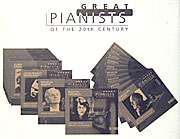 To that end, the project is wildly successful – absorbing one of these volumes reveals as much of its subject as a detailed biography or analysis. Once you're willing to submit to the producers' quirks, this edition affords a wealth of fabulous pianism that combines stunning technique, profound musical understanding and brilliant interpretive insight. To that end, the project is wildly successful – absorbing one of these volumes reveals as much of its subject as a detailed biography or analysis. Once you're willing to submit to the producers' quirks, this edition affords a wealth of fabulous pianism that combines stunning technique, profound musical understanding and brilliant interpretive insight.
But where do you start? Philips has made that an easy choice. For the price of a single mid-line CD, they've packaged a hardcover book of artist bios and a piano history with a 2-CD sampler of selections from all but two of the artists (licensing problems?), graced with cogent performance notes. But don't mistake Philips's gesture for generosity. Hearing this stuff is addictive and you'll be sorely tempted to plunge into the full Edition.
The sampler will help guide you to your own favorites. Here are mine among the first fifty volumes. They're in no particular order; my current favorite invariably is the one I've heard most recently.
- Schnabel's Beethoven, Kempff's Brahms, Rubinstein's Chopin, Cortot's Schumann, Richter's Prokofiev and Laroccha's Albinez all are utterly transparent - they sublimate ego to achieve full identification with a composer's expression - and thus represent the ultimate triumph of truly great artistry.
- Along with Schnabel and Cortot, Lhevinne and Rachmaninoff were "Golden Age" pianists, whose authenticity arose from immersion in the very tradition that produced our core repertoire; while younger artists try to emulate that vision, these guys lived it.
- Rosalyn Tureck recreates Bach with rarefied feeling.
- Maria Yudina jolts often staid Bach and Beethoven variations with electrifying authority.
- Alfred Brendel presents Haydn and Schubert with sparkling clarity.
- Clifford Curzon presents Mozart and the same Schubert with exquisite sensitivity.
- Shura Cherkassky imbues Chopin with sweeping personal poetry.
- Mikhail Pletnev enlivens his Tchaikovsky with balletic elan.
- Arturo Benedetti Michelangeli colors the impressionists with radiant hues.
- John Ogden revitalizes unusual repertoire with compelling intensity.
- Lyubov Bruk and Mark Taimanov, duo-pianists, may double your pleasure.
- Byron Janis, Julius Katchen and Leon Fleisher are quintessentially American - bold and brash.
- Evgeny Kissin dazzles as a phenomenal teenage prodigy.
- Dinu Lipatti, Clara Haskil and Ingrid Haebler communicate with disarming directness.
- Ivan Moravec plays so smoothly you'll forget that his piano's a percussion instrument.
- Maurizio Pollini, Zoltan Koksis, Vladimir Ashkenazy, Alexis Weissenberg and Martha Argerich play with clean, modern splendor that defies pigeon-holing.
- Nothing, though, matches the inspiration of a live concert. If I had to choose just one volume as a great place to start it would be the first devoted to Sviatoslav Richter, which combines his definitive Prokofiev with a staggeringly intense 1958 Sofia recital that amply validates why many consider Richter to have been the pianist of the century. Also wondrous is an awesome 1974 concert of Bach, Chopin and flashy showpieces by Jorge Bolet.
I'm even thrilled with the packaging, a rare emotion since the demise of gatefold LPs. 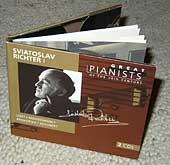 In lieu of a clunky double jewelbox, each volume comes as a DigiPak, a hardback book with stiff paper CD sleeves glued to the inside covers and the notes bound in between. The DigiPak takes up the same space as a single jewelbox, but it's far more attractive and sturdy. In lieu of a clunky double jewelbox, each volume comes as a DigiPak, a hardback book with stiff paper CD sleeves glued to the inside covers and the notes bound in between. The DigiPak takes up the same space as a single jewelbox, but it's far more attractive and sturdy.
It's great to see a major label adopt a sensible alternative to the crummy jewelbox. Boy, do I hate those things! Oh, I know all the marketing rationales. Durable? Try dropping one on the floor. Attractive? Not unless you've got a plastic fetish. Compact? They're mostly wasted space, hogging three times the room needed for a CD, booklet and paper sleeve. And all the crocodile tears once shed over the longbox pale compared to the sheer environmental waste of these things, which promise to bloat landfills for generations to come.
But the DigiPaks do present a slight problem - it's nearly impossible to extract the discs from their tight sleeves without fingerprinting and scratching them; not with major globs and gouges that cause mistracking, but the type that leads clerks in used CD stores to feign agony. If you're up for an art project, you can cut out an hourglass piece from the top of the sleeve to the center hole and then guide the CD in and out with your finger - an inconvenience, perhaps, but well worth escaping the tyranny of the jewelbox. it's nearly impossible to extract the discs from their tight sleeves without fingerprinting and scratching them; not with major globs and gouges that cause mistracking, but the type that leads clerks in used CD stores to feign agony. If you're up for an art project, you can cut out an hourglass piece from the top of the sleeve to the center hole and then guide the CD in and out with your finger - an inconvenience, perhaps, but well worth escaping the tyranny of the jewelbox.
Oh, one thing more. As if 200 CDs were not enough, the producer mentioned in a Gramophone interview that he was working on another hundred volumes! Amid the abundant glories of the present edition, I won't deny that I just may have wished for that!
= = = = = = = = = = = = =
Hopefully, my overall enthusiasm for the marvels of the "Great Pianists of the 20th Century" Edition is amply evident from the foregoing column I had written concerning the first half. Once the remaining fifty volumes had been released, I updated my recommendations to cover some highlights of the rest somewhat more expansively without the constraints of print limitations. In late 2005 I went back to provide others (Backhaus, Barenboim, Bruk/Taimanov, Cliburn, Cortot, Cziffra, Francois, Friedman, Gieseking, Haskil, Katchen, Kissin, the Lhevinnes, Moiseiwitch, Moravec, Paderewski, Pletnev, Previn, Rachmaninoff, Schnabel and Uchida). The ones I've omitted are simply those for which I found I had little to say, as well as those about whom others have written extensively.
- Geza Anda (1921 - 1976) - Just call this volume Geza Anda's Greatest Hits. Anda is best remembered for one of the greatest early triumphs of crossover marketing,
 in the ancient times before soundtrack albums. His ravishing 1961 rendition (at the keyboard and conducting) of the andante of Mozart's Piano Concerto # 21 in C was popularized as the theme from the 1967 Swedish romantic film Elvira Madigan, which then returned the favor when Anda's original album was reissued with a wistful cover portrait of the lead actress and became a smash hit - deservedly so, as the performance is truly exquisite, lush but with ample respect for Mozart's chamber sonority. The net result: even today, the Mozart 21st is still known as the "Elvira Madigan" Concerto. Among classical buffs, though, Anda is better remembered for his fabulous idiomatic set of the Bartok Piano Concertos with Ferenc Fricsay and the RSO Berlin. Connoisseurs further revere Anda for his deeply contemplative set of the Chopin Waltzes, waxed in his final half-year. All three performances comprise this fine edition. in the ancient times before soundtrack albums. His ravishing 1961 rendition (at the keyboard and conducting) of the andante of Mozart's Piano Concerto # 21 in C was popularized as the theme from the 1967 Swedish romantic film Elvira Madigan, which then returned the favor when Anda's original album was reissued with a wistful cover portrait of the lead actress and became a smash hit - deservedly so, as the performance is truly exquisite, lush but with ample respect for Mozart's chamber sonority. The net result: even today, the Mozart 21st is still known as the "Elvira Madigan" Concerto. Among classical buffs, though, Anda is better remembered for his fabulous idiomatic set of the Bartok Piano Concertos with Ferenc Fricsay and the RSO Berlin. Connoisseurs further revere Anda for his deeply contemplative set of the Chopin Waltzes, waxed in his final half-year. All three performances comprise this fine edition.
- Martha Argerich (b. 1941), volume 2 - Beyond exciting accounts of the Schumann Second and Liszt b minor Sonatas, the emphasis here is on Chopin,
 including the complete Preludes and Third Sonata. Argerich's approach provides a clear rebuke to classical gender stereotyping: the Chopin of Anda, Cherhassky, Moravec and other guys in the Great Pianists Edition oozes soft, gentle, nurturing sensitivity - "effeminate," if you will - while Argerich's is aggressive, bold, temperamental and edgy. There's lots of beauty, but it's the type that emerges in contrast to rough, elemental power. There's also plenty of romanticism here - not the pale, wispy pining sort, but one that seems to better reflect the ardent, fevered, emotional tumult of a young, conflicted composer. This is a stunning collection. including the complete Preludes and Third Sonata. Argerich's approach provides a clear rebuke to classical gender stereotyping: the Chopin of Anda, Cherhassky, Moravec and other guys in the Great Pianists Edition oozes soft, gentle, nurturing sensitivity - "effeminate," if you will - while Argerich's is aggressive, bold, temperamental and edgy. There's lots of beauty, but it's the type that emerges in contrast to rough, elemental power. There's also plenty of romanticism here - not the pale, wispy pining sort, but one that seems to better reflect the ardent, fevered, emotional tumult of a young, conflicted composer. This is a stunning collection.
- Wilhelm Backhaus (1884 - 1969) - The notes by Piero Rattalino recall that Backhaus, whose recording career began with the first full concerto ever committed to disc (Grieg’s, in 1910),
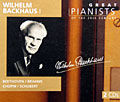 was prized by producers of the time for his calm demeanor that achieved continuity across the required side breaks, a practical boon but one that carried an aesthetic limitation - an “expressive modesty that … borders on coldness.” Indeed, it’s hard to muster much enthusiasm for his 1952 Brahms Concerto # 2 with Schuricht and the Vienna Philharmonic, coming midway between his acclaimed 1939 and 1967 accounts with Bohm (and the Saxon State and Vienna Philharmonic Orchestras, respectively) – despite shrill sound, it’s attentive, solid and thoroughly idiomatic, yet superfluous, given the realm of other fine recordings nowadays with superior sound and/or inspiration. Fortunately, the rest of this collection is far more interesting. Five Beethoven sonatas (the “Pathetique,” “Tempest,” “Les adieux,” Op. 79 and Op. 111) present one of his foremost specialties, where a dry directness and lack of emotion seem especially apt. All are from a March 1954 concert. While it’s nice to have a supplement to his Decca stereo studio recordings of these works, they’re barely distinguishable, trading only slightly greater animation for simplified dynamics, lesser inflection, and far thinner sonics. Of several encores (all live as well), a Chopin Etude in f minor, Op. 25 # 2 and a Brahms Intermezzo in C, Op. 119 # 3 are beautifully played and organized without a hint of ostentation but with breathtakingly secure technique and the most subtle of rhythmic inflection. Alongside the Beethoven, they document a self-effacing artist with sufficient confidence to let the music speak for itself. was prized by producers of the time for his calm demeanor that achieved continuity across the required side breaks, a practical boon but one that carried an aesthetic limitation - an “expressive modesty that … borders on coldness.” Indeed, it’s hard to muster much enthusiasm for his 1952 Brahms Concerto # 2 with Schuricht and the Vienna Philharmonic, coming midway between his acclaimed 1939 and 1967 accounts with Bohm (and the Saxon State and Vienna Philharmonic Orchestras, respectively) – despite shrill sound, it’s attentive, solid and thoroughly idiomatic, yet superfluous, given the realm of other fine recordings nowadays with superior sound and/or inspiration. Fortunately, the rest of this collection is far more interesting. Five Beethoven sonatas (the “Pathetique,” “Tempest,” “Les adieux,” Op. 79 and Op. 111) present one of his foremost specialties, where a dry directness and lack of emotion seem especially apt. All are from a March 1954 concert. While it’s nice to have a supplement to his Decca stereo studio recordings of these works, they’re barely distinguishable, trading only slightly greater animation for simplified dynamics, lesser inflection, and far thinner sonics. Of several encores (all live as well), a Chopin Etude in f minor, Op. 25 # 2 and a Brahms Intermezzo in C, Op. 119 # 3 are beautifully played and organized without a hint of ostentation but with breathtakingly secure technique and the most subtle of rhythmic inflection. Alongside the Beethoven, they document a self-effacing artist with sufficient confidence to let the music speak for itself.
- Daniel Barenboim (b. 1942) - This set provides two snapshots that barely suggest the breadth of Barenboim’s career. The first is from 1971.
 An entire CD is devoted to two of his collaborations with Otto Klemperer that year – the Mozart Concerto # 25 and the Beethoven Concerto # 1. True, they document the taming of a young soloist by the respected control of a wizened elder master, plus Klemperer enlivens the orchestra with prominent winds that leaven his deliberate tempi and presciently suggest the sonority of the late classical era, but one (or even a single movement) would have sufficed to make the point. Also from 1971 is his Brahms Concerto # 1 with Barbirolli leading the Philharmonia, an unusually deliberate reading that seems more ponderous rather than inspired, missing much of the profundity later mined by Zimerman and Bernstein’s similar approach. The second snapshot is the three Liszt Sonetti del Petrarca from 1980 and the Liszt arrangement of Wagner’s Isolde’s Liebestod from 1982. Here, too, a single example would have been enough and, indeed, the notes concede that the passionate Liszt is surprisingly nonchalant. Admittedly, Barenboim’s fame as a conductor (emerging as one of our preeminent Beethoven and Bruckner conductors in the footsteps of his idol Furtwangler) is beyond the scope of this Edition, but what of his wonderful chamber music in which his romantic tendencies were in full bloom, especially when partnering his wife, the great cellist Jacqueline du Pré? Or, as the pathway to his conducting career, one of the Mozart concerti which he both played and conducted from the keyboard? Snapshots can be interesting, but it’s often hard to infer from them the richness of their surroundings. An entire CD is devoted to two of his collaborations with Otto Klemperer that year – the Mozart Concerto # 25 and the Beethoven Concerto # 1. True, they document the taming of a young soloist by the respected control of a wizened elder master, plus Klemperer enlivens the orchestra with prominent winds that leaven his deliberate tempi and presciently suggest the sonority of the late classical era, but one (or even a single movement) would have sufficed to make the point. Also from 1971 is his Brahms Concerto # 1 with Barbirolli leading the Philharmonia, an unusually deliberate reading that seems more ponderous rather than inspired, missing much of the profundity later mined by Zimerman and Bernstein’s similar approach. The second snapshot is the three Liszt Sonetti del Petrarca from 1980 and the Liszt arrangement of Wagner’s Isolde’s Liebestod from 1982. Here, too, a single example would have been enough and, indeed, the notes concede that the passionate Liszt is surprisingly nonchalant. Admittedly, Barenboim’s fame as a conductor (emerging as one of our preeminent Beethoven and Bruckner conductors in the footsteps of his idol Furtwangler) is beyond the scope of this Edition, but what of his wonderful chamber music in which his romantic tendencies were in full bloom, especially when partnering his wife, the great cellist Jacqueline du Pré? Or, as the pathway to his conducting career, one of the Mozart concerti which he both played and conducted from the keyboard? Snapshots can be interesting, but it’s often hard to infer from them the richness of their surroundings.
- Jorge Bolet (1914 - 1990), Volume II - Here's another superb Liszt collection to place alongside the Horowitz, Cziffra and Ogden volumes. But even beyond its intrinsic splendor,
 this set highlights the glory of the medium of recordings, which we often disparage in favor of concerts. Indeed, Bolet's own volume I is devoted to a stunning 1974 Carnegie Hall recital, the liner notes to which carp that Bolet was far happier before an audience, and suggesting that his studio work was cautious and less inspired. But that's simply not true. While concerts and records are surely different media, neither is inherently superior to the other. The edgy fireworks of a concert are indeed thrilling to experience (and indeed are fitting to keep the attention of the audience) but can tend to wear thin over repeated hearings. Great studio recordings, intended to be savored in private, can wield a more subtle but perhaps more lasting power that transcends the moment. While avoiding the the greater visceral excitement and risk-taking of a concert, Bolet's studio Liszt exerts a unique spell - confident, relaxed, finely-structured, and assertive without being overwhelming. Take, for example, the Harmonies du Soir. Richter's stunning live 1958 Sofia version (on his Volume I) builds to a shattering climax, rendered in white heat with blazing virtuosity, leaving the listener drained with exhaustion. Bolet's, though, gleams with a subtlety that could get lost in the concert hall, pulsing instead with an ebb and flow of fluid feeling, lifting you up and letting you down gently in the peace of your home. The marvel begs to be heard again as soon as it's over - a special type of magic that only recordings can conjure. this set highlights the glory of the medium of recordings, which we often disparage in favor of concerts. Indeed, Bolet's own volume I is devoted to a stunning 1974 Carnegie Hall recital, the liner notes to which carp that Bolet was far happier before an audience, and suggesting that his studio work was cautious and less inspired. But that's simply not true. While concerts and records are surely different media, neither is inherently superior to the other. The edgy fireworks of a concert are indeed thrilling to experience (and indeed are fitting to keep the attention of the audience) but can tend to wear thin over repeated hearings. Great studio recordings, intended to be savored in private, can wield a more subtle but perhaps more lasting power that transcends the moment. While avoiding the the greater visceral excitement and risk-taking of a concert, Bolet's studio Liszt exerts a unique spell - confident, relaxed, finely-structured, and assertive without being overwhelming. Take, for example, the Harmonies du Soir. Richter's stunning live 1958 Sofia version (on his Volume I) builds to a shattering climax, rendered in white heat with blazing virtuosity, leaving the listener drained with exhaustion. Bolet's, though, gleams with a subtlety that could get lost in the concert hall, pulsing instead with an ebb and flow of fluid feeling, lifting you up and letting you down gently in the peace of your home. The marvel begs to be heard again as soon as it's over - a special type of magic that only recordings can conjure.
- Lyubov Bruk (1926 - 1996) and Mark Taimanov (b. 1926) - Nope, I never heard of them either before this. Interestingly, though, it turns out that Taimanov is far more famed in chess circles,
 where for many years he was ranked among the world’s top ten masters. A variation of the Sicilian opening is even named after him. (His chess career crashed in 1971 when he lost 6-0 to then-American Bobby Fischer in the world championship quarter rounds. Despite his loyalty (a picture in the booklet shows him playing chess as Che Guevara looks on), the Soviets felt so embarrassed as to strip him of his salary and travel privileges.) But it’s his musical calling that’s the focus here. In the notes he provided, Taimanov recalls beginning to play together with Bruk as 12-year old students, an association that led to marriage and continued for over 3 decades until they parted ways. He calls theirs a “unity of opposites” – she was delicate and refined, he outgoing and romantic. As heard here, though, the commonality of approach and close coordination are truly remarkable, perhaps arising from their long-time spiritual union. Aside from its technical challenges (it’s hard enough for a single brain to manage ten fingers, but far more demanding for two independent minds to coordinate 20), the use of two pianos produces not only thicker textures but the opportunity for more complexity and a heady rush of more notes than two hands can produce. Taimanov claims that most of their repertoire was recorded. Frustratingly, though, this volume omits many of the pieces he cites as particular favorites (by Saint-Saens, Schumann and Mendelssohn), as well as others, now obscure, written especially for them. All would be fascinating to hear (and seem otherwise unavailable). Of the material that is included, Taimanov and Bruk display a fine range of feeling appropriate to each work. While their background and training suggest a natural affinity for the Arensky and Rachmaninoff Suites for Two Pianos, their Mozart (the Concerto for Two Pianos, KV 365) and Busoni Duetto concertante (modeled after the finale of Mozart’s Piano Concerto in F, KV 459) are nicely animated rather than classically restrained, and the rarely-heard Chopin Rondo for Two Pianos in C, Op. 73 gives free rein to the poles of their personalities. Perhaps most fascinating and unexpected is their French repertoire, in which they capture the dry wit and abundant energy of Milhaud’s Scaramouche and Poulenc’s Concerto for Two Pianos and Sonata for Two Pianos. where for many years he was ranked among the world’s top ten masters. A variation of the Sicilian opening is even named after him. (His chess career crashed in 1971 when he lost 6-0 to then-American Bobby Fischer in the world championship quarter rounds. Despite his loyalty (a picture in the booklet shows him playing chess as Che Guevara looks on), the Soviets felt so embarrassed as to strip him of his salary and travel privileges.) But it’s his musical calling that’s the focus here. In the notes he provided, Taimanov recalls beginning to play together with Bruk as 12-year old students, an association that led to marriage and continued for over 3 decades until they parted ways. He calls theirs a “unity of opposites” – she was delicate and refined, he outgoing and romantic. As heard here, though, the commonality of approach and close coordination are truly remarkable, perhaps arising from their long-time spiritual union. Aside from its technical challenges (it’s hard enough for a single brain to manage ten fingers, but far more demanding for two independent minds to coordinate 20), the use of two pianos produces not only thicker textures but the opportunity for more complexity and a heady rush of more notes than two hands can produce. Taimanov claims that most of their repertoire was recorded. Frustratingly, though, this volume omits many of the pieces he cites as particular favorites (by Saint-Saens, Schumann and Mendelssohn), as well as others, now obscure, written especially for them. All would be fascinating to hear (and seem otherwise unavailable). Of the material that is included, Taimanov and Bruk display a fine range of feeling appropriate to each work. While their background and training suggest a natural affinity for the Arensky and Rachmaninoff Suites for Two Pianos, their Mozart (the Concerto for Two Pianos, KV 365) and Busoni Duetto concertante (modeled after the finale of Mozart’s Piano Concerto in F, KV 459) are nicely animated rather than classically restrained, and the rarely-heard Chopin Rondo for Two Pianos in C, Op. 73 gives free rein to the poles of their personalities. Perhaps most fascinating and unexpected is their French repertoire, in which they capture the dry wit and abundant energy of Milhaud’s Scaramouche and Poulenc’s Concerto for Two Pianos and Sonata for Two Pianos.
- Robert Casadesus (1899 - 1972) - The perceptive notes by Farhan Malik pinpoint the "problem" in attempting to describe Casadesus's art - you really can't.
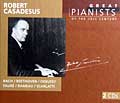 Casadesus is perhaps best heard as a bridge between centuries and cultures. Born in 1899, he may have been the "last great pianist of the 19th century" and indeed, although allied with the French modernists, his style was of the old school - heavy rather than elegant, with lots of detail subsumed into structural attention. The first disc is devoted to Baroque (Bach, Rameau and Scarlatti), with precise articulation imbued with feeling and inflection, and early Beethoven (the Sonata # 2), gentle and light. The second disc begins by documenting one of the great duo-piano teams on record - Robert and his wife Gaby, who imbue Faure's Dolly Suite and especially Debussy's En Blanc et Noir with exquisite feeling and deep emotional coordination; it's a shame that the Six Epigraphes Antiques, its original LP companion, is omitted, despite ample CD capacity. Robert then flatters Faure solo pieces with his devoted attention. The set concludes with his 1947 Ravel Piano Concerto in D for the Left Hand with Ormandy and the Philadelphia Orchestra, which is not only deservedly famous in its own right but also rings with authority stemming from the close association between performer and composer. Casadesus is perhaps best heard as a bridge between centuries and cultures. Born in 1899, he may have been the "last great pianist of the 19th century" and indeed, although allied with the French modernists, his style was of the old school - heavy rather than elegant, with lots of detail subsumed into structural attention. The first disc is devoted to Baroque (Bach, Rameau and Scarlatti), with precise articulation imbued with feeling and inflection, and early Beethoven (the Sonata # 2), gentle and light. The second disc begins by documenting one of the great duo-piano teams on record - Robert and his wife Gaby, who imbue Faure's Dolly Suite and especially Debussy's En Blanc et Noir with exquisite feeling and deep emotional coordination; it's a shame that the Six Epigraphes Antiques, its original LP companion, is omitted, despite ample CD capacity. Robert then flatters Faure solo pieces with his devoted attention. The set concludes with his 1947 Ravel Piano Concerto in D for the Left Hand with Ormandy and the Philadelphia Orchestra, which is not only deservedly famous in its own right but also rings with authority stemming from the close association between performer and composer.
- Van Cliburn (b. 1934) - Like Casals, Paderewski and Hess, Van Cliburn will be remembered as much for politics as music. During the height of the Cold War,
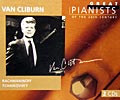 the lanky young Texan ventured to Moscow where he won the first Tchaikovsky Competition and wowed Russian audiences with his open attitude and magnificent playing of “their” music. When he returned home to a ticker-tape parade and a hero’s welcome, Time hailed him as “Horowitz, Liberace and Presley all rolled into one.” Two days after his triumphant homecoming, he recorded the Rachmaninoff Third and 11 days later the Tchaikovsky First, the concertos with which he had won the final round of the Competition, both in Carnegie Hall with Kirill Kondrashin, the conductor who had accompanied him. Released to huge acclaim, the Tchaikovsky became the first million-selling classical LP. But that was in 1958. What of the music? In liner notes to the Rachmaninoff LP, David Sarnoff wrote: “If one seeks an explanation for Van Cliburn’s magnetism, I would simply say that it is musical control coupled with spontaneous beauty.” In the New Yorker, Winthrop Sargeant called Cliburn the “living representative of the great 19th and early 20th century school of virtuosity” with tasteful rubato, a sure sense of phrasing, feeling for restraint and an overall musical sensitivity. That about sums it up – despite potent technique, Cliburn eschews thundering keyboard power for masterful, solid warmth. Such a style seems authentic. The best comparison for the Tchaikovsky is the magnificent 1926 recording by Vassily Sapellnikoff, whom the composer considered his foremost exponent; while it’s generally faster (perhaps to fit onto eight 12-inch sides) and begins with impetuous phrasing and huge dynamic accents, it soon settles into lyric elegance. Rachmaninoff’s own 1939 recording of his Third with Ormandy and the Philadelphia Orchestra reflects similar moderation and refinement. The rest of this collection presents a deeply-felt live 1960 Moscow taping of the Rachmaninoff Sonata # 2, and a 1970s collection of short pieces. Among these, perhaps the most surprising is the Etude-Tableau in e-flat minor which avoids a temptation to storm the heavens for equally effective heart-melting pleading. While much of his other work tended to be overlooked, within the limits of his narrow repertoire Cliburn still comes across as a musical champion. the lanky young Texan ventured to Moscow where he won the first Tchaikovsky Competition and wowed Russian audiences with his open attitude and magnificent playing of “their” music. When he returned home to a ticker-tape parade and a hero’s welcome, Time hailed him as “Horowitz, Liberace and Presley all rolled into one.” Two days after his triumphant homecoming, he recorded the Rachmaninoff Third and 11 days later the Tchaikovsky First, the concertos with which he had won the final round of the Competition, both in Carnegie Hall with Kirill Kondrashin, the conductor who had accompanied him. Released to huge acclaim, the Tchaikovsky became the first million-selling classical LP. But that was in 1958. What of the music? In liner notes to the Rachmaninoff LP, David Sarnoff wrote: “If one seeks an explanation for Van Cliburn’s magnetism, I would simply say that it is musical control coupled with spontaneous beauty.” In the New Yorker, Winthrop Sargeant called Cliburn the “living representative of the great 19th and early 20th century school of virtuosity” with tasteful rubato, a sure sense of phrasing, feeling for restraint and an overall musical sensitivity. That about sums it up – despite potent technique, Cliburn eschews thundering keyboard power for masterful, solid warmth. Such a style seems authentic. The best comparison for the Tchaikovsky is the magnificent 1926 recording by Vassily Sapellnikoff, whom the composer considered his foremost exponent; while it’s generally faster (perhaps to fit onto eight 12-inch sides) and begins with impetuous phrasing and huge dynamic accents, it soon settles into lyric elegance. Rachmaninoff’s own 1939 recording of his Third with Ormandy and the Philadelphia Orchestra reflects similar moderation and refinement. The rest of this collection presents a deeply-felt live 1960 Moscow taping of the Rachmaninoff Sonata # 2, and a 1970s collection of short pieces. Among these, perhaps the most surprising is the Etude-Tableau in e-flat minor which avoids a temptation to storm the heavens for equally effective heart-melting pleading. While much of his other work tended to be overlooked, within the limits of his narrow repertoire Cliburn still comes across as a musical champion.
- Alfred Cortot (1877 - 1962) - Cortot most often is mentioned nowadays for two traits. This first is a quality of free expression that permeates his performances.
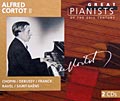 Alfred Brendel called it control in the guise of improvisation and characterized Cortot’s playing as three-dimensional, “equally satisfying my mind, my senses and my emotions.” Indeed, his spontaneous approach, while occasionally seeming a random affectation (as in his volatile 1926 Liszt Hungarian Rhapsody # 2 heard here), constantly impresses as an effort to elucidate the structure and distinctive essence of a piece. Such a method seems essential in the rambling expanses of Franck (here, the Prelude, choral et fugue, the Prelude, aria et final and the Variations symphoniques), helpful to illuminate the tonal meandering of Debussy (here, the Preludes, Book I), and especially fascinating in the well-worn Preludes and Études of Chopin, where fresh direction is welcome and where Cortot constantly probes to challenge our assumptions. The other quality, alas, is technical imprecision. As Harold Schonberg notes, Cortot was not only a preeminent soloist, but a famed conductor, chamber musician, teacher, educator, editor and author. With such multi-faceted demanding careers, “How could he possibly find time to keep his fingers in shape? The answer is simple: he didn’t.” Indeed, his recordings show a precipitous decline in technique, beginning with his near-perfect Victor acousticals (represented here by a 1923 Ravel Jeux d’eau) and superb trios with Casals and Thibaud (readily available on Naxos and elsewhere), slipping somewhat in his early electrical solos, and sadly diminished in his LP remakes. The unfortunate culmination is on clear display in his Schumann here. Although the album credits mislabel his Études symphoniques and Carnaval as his acclaimed 1928-9 versions, they in fact are his 1953 remakes, of perverse interest to collectors but otherwise crude and graceless compared to the versions they purport to be. (The 1935 Kreisleriana was his only recording, according to the discography compiled by Farhan Malik, but it's far from flawless.) Yet, even those impress in a way – the sheer feeling behind the playing combines with the flaws to produce a pervasive quality of humanity that enhances Cortot’s achievement and seems a small price to pay to relive his inspired and impulsive poetry. Alfred Brendel called it control in the guise of improvisation and characterized Cortot’s playing as three-dimensional, “equally satisfying my mind, my senses and my emotions.” Indeed, his spontaneous approach, while occasionally seeming a random affectation (as in his volatile 1926 Liszt Hungarian Rhapsody # 2 heard here), constantly impresses as an effort to elucidate the structure and distinctive essence of a piece. Such a method seems essential in the rambling expanses of Franck (here, the Prelude, choral et fugue, the Prelude, aria et final and the Variations symphoniques), helpful to illuminate the tonal meandering of Debussy (here, the Preludes, Book I), and especially fascinating in the well-worn Preludes and Études of Chopin, where fresh direction is welcome and where Cortot constantly probes to challenge our assumptions. The other quality, alas, is technical imprecision. As Harold Schonberg notes, Cortot was not only a preeminent soloist, but a famed conductor, chamber musician, teacher, educator, editor and author. With such multi-faceted demanding careers, “How could he possibly find time to keep his fingers in shape? The answer is simple: he didn’t.” Indeed, his recordings show a precipitous decline in technique, beginning with his near-perfect Victor acousticals (represented here by a 1923 Ravel Jeux d’eau) and superb trios with Casals and Thibaud (readily available on Naxos and elsewhere), slipping somewhat in his early electrical solos, and sadly diminished in his LP remakes. The unfortunate culmination is on clear display in his Schumann here. Although the album credits mislabel his Études symphoniques and Carnaval as his acclaimed 1928-9 versions, they in fact are his 1953 remakes, of perverse interest to collectors but otherwise crude and graceless compared to the versions they purport to be. (The 1935 Kreisleriana was his only recording, according to the discography compiled by Farhan Malik, but it's far from flawless.) Yet, even those impress in a way – the sheer feeling behind the playing combines with the flaws to produce a pervasive quality of humanity that enhances Cortot’s achievement and seems a small price to pay to relive his inspired and impulsive poetry.
- Gyorgy Cziffra (1921 - 1994) - While the temptation to match artistic temperament with biographical background often fails, it’s hard to dismiss the impact Cziffra’s gypsy parentage,
 time as a POW, three years of hard labor and ultimate escape to Vienna must have had in shaping his outlook. Cziffra’s complete 1962 set of the Chopin Études is frighteningly intense, as he constantly upends expectations and peers deeply into the darkest regions of the composer’s soul. Thus, the very first étude is deliberately lumpy, the second mechanically joyless, the “Black Key” brittle and drained of all its accustomed grace, the C# minor thrashingly violent and full of rhythmic and dynamic distension, the “Revolutionary” suffused with anguish, and Op. 25, # 7 so tortured with impatience that it’s simply impossible to beat its time. This is a deeply challenging, exhausting encounter, utterly unique among all the fine, idiomatic renditions on record. (The CD closes, though, with a “Heroic” Polonaise that’s equally puzzling – restrained, gentle and barely inflected.) The other CD will be far less controversial – a collection of Liszt powerhouse pieces that unquestionably fit Cziffra’s volatile and edgy temperament, ranging from the pristine beauty of the Sonetto 123 del Petrarca and the profound peace of “Un sospiro” to the severe formality of the Fantasy and Fugue on the Name B-A-C-H, the spiritual elevation of the Legende No. 2, the heroism of the Polonaise No. 2 and the dense volitility of the Mephisto Waltz No. 1 time as a POW, three years of hard labor and ultimate escape to Vienna must have had in shaping his outlook. Cziffra’s complete 1962 set of the Chopin Études is frighteningly intense, as he constantly upends expectations and peers deeply into the darkest regions of the composer’s soul. Thus, the very first étude is deliberately lumpy, the second mechanically joyless, the “Black Key” brittle and drained of all its accustomed grace, the C# minor thrashingly violent and full of rhythmic and dynamic distension, the “Revolutionary” suffused with anguish, and Op. 25, # 7 so tortured with impatience that it’s simply impossible to beat its time. This is a deeply challenging, exhausting encounter, utterly unique among all the fine, idiomatic renditions on record. (The CD closes, though, with a “Heroic” Polonaise that’s equally puzzling – restrained, gentle and barely inflected.) The other CD will be far less controversial – a collection of Liszt powerhouse pieces that unquestionably fit Cziffra’s volatile and edgy temperament, ranging from the pristine beauty of the Sonetto 123 del Petrarca and the profound peace of “Un sospiro” to the severe formality of the Fantasy and Fugue on the Name B-A-C-H, the spiritual elevation of the Legende No. 2, the heroism of the Polonaise No. 2 and the dense volitility of the Mephisto Waltz No. 1
- Christoph Eschenbach (b. 1940) - Here is another bold, exciting performer who transforms everything he encounters with sensationally clean articulation into a vibrant,
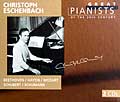 living experience. But for every rule there's an exception, and here it's a more earth-bound Beethoven First Concerto with von Karajan, to whose literalism Eschenbach bends his own inspiration to produce a strong if characterless reading in which the extended four-minute cadenza and an exquisite adagio speak more eloquently than the rest. The rest of his program is both generous (both discs run over 80 minutes) and striking - breathtakingly swift Haydn sonatas, precise and eloquent Mozart (the "Ah, vous dirai-je, Maman" Variations and the Sonata in F, K. 332), sparkling early Schumann (the "Abegg" Variations and Op. 4 Intermezzi) and a sharply-etched Schubert Sonata in A, D. 959. living experience. But for every rule there's an exception, and here it's a more earth-bound Beethoven First Concerto with von Karajan, to whose literalism Eschenbach bends his own inspiration to produce a strong if characterless reading in which the extended four-minute cadenza and an exquisite adagio speak more eloquently than the rest. The rest of his program is both generous (both discs run over 80 minutes) and striking - breathtakingly swift Haydn sonatas, precise and eloquent Mozart (the "Ah, vous dirai-je, Maman" Variations and the Sonata in F, K. 332), sparkling early Schumann (the "Abegg" Variations and Op. 4 Intermezzi) and a sharply-etched Schubert Sonata in A, D. 959.
- Edwin Fischer (1886 - 1960), volume 1 - Nowadays we are so used to "authentic" period renditions of Bach played with phenomenal precision on original instruments
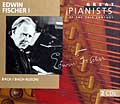 that we tend to forget that there is another way to approach this most universal of all composers. Fischer is a glorious throwback who plays his Bach on the concert grand with an exquisite velvet touch and boatloads of personal inflection. While his renditions of three piano concertos and excerpts from "The 48" are revelatory, especially startling are three fantasy pieces, in which his free-wheeling departures from modern interpretive expectations are especially strong and uniquely compelling. Which style is truly the more authentic? From a purely emotional point of view, they're equally valid and only serve to prove the futility of aesthetic arguments in face of the transcendent universality of Bach's timeless art. that we tend to forget that there is another way to approach this most universal of all composers. Fischer is a glorious throwback who plays his Bach on the concert grand with an exquisite velvet touch and boatloads of personal inflection. While his renditions of three piano concertos and excerpts from "The 48" are revelatory, especially startling are three fantasy pieces, in which his free-wheeling departures from modern interpretive expectations are especially strong and uniquely compelling. Which style is truly the more authentic? From a purely emotional point of view, they're equally valid and only serve to prove the futility of aesthetic arguments in face of the transcendent universality of Bach's timeless art.
- Edwin Fischer, volume 2 - Fischer's first volume is devoted to his lovely, rich, old-fashioned Bach. The second, exploring the rest of the core German
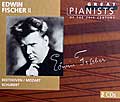 repertoire in which he specialized, is fueled by two marvelous concerto recordings. His 1933 account of the Mozart Concerto # 20 is lean, pointed, vital and heartfelt without sentimentality. His 1951 reading of the Beethoven Emperor with Furtwangler and the Philharmonia generates a far different excitement, charged with spiritual drama from the closely-attuned philosophical interplay of soloist and conductor deeply immersed in German tradition. The second disc presents the Mozart Fantasia in c minor, K. 475, the Schubert Impromptus, D. 899 and the Beethoven Appassionata and Op. 110 Sonatas, all played with a direct, natural, self-effacing and utterly convincing manner that sounds ineffably right. Fischer's art is not colorful, but it has infinite degrees of careful shading. repertoire in which he specialized, is fueled by two marvelous concerto recordings. His 1933 account of the Mozart Concerto # 20 is lean, pointed, vital and heartfelt without sentimentality. His 1951 reading of the Beethoven Emperor with Furtwangler and the Philharmonia generates a far different excitement, charged with spiritual drama from the closely-attuned philosophical interplay of soloist and conductor deeply immersed in German tradition. The second disc presents the Mozart Fantasia in c minor, K. 475, the Schubert Impromptus, D. 899 and the Beethoven Appassionata and Op. 110 Sonatas, all played with a direct, natural, self-effacing and utterly convincing manner that sounds ineffably right. Fischer's art is not colorful, but it has infinite degrees of careful shading.
- Leon Fleisher (b. 1928) - This set, to me, is a sadly missed opportunity. Although not by choice, Fleisher has established a unique reputation as a champion and superb
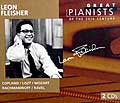 interpreter of the literature for the left hand alone. All we get here of it, though, is the Ravel Concerto for the Left Hand. Fleisher's performance is superb, but it's hardly unique; indeed, those of Katchen and Casadesus are included in their volumes of this same Edition. The rest of the Fleisher set consists of his youthful records of Liszt, Copland, Mozart and Weber sonatas, recorded prior to the mid-sixties when he lost the use of his right hand to a nervous affliction. (Most recently, has recovered its use and issued an album of two-hand music to great acclaim.) Fine as these are, the producers missed a great opportunity to present Fleisher in a realm in which he alone reigns supreme. The left-handed literature may not overflow with great masterpieces, but it provides a fascinating demonstration of using musical resources to overcome fearsome limitations. And perhaps that is the ultimate value of such pieces -- they epitomize the wonder of art, which uses everyday materials within structural confines to lift us above the physical world into a far more extraordinary and limitless one. The portrait of Fleisher presented here is one of sad regret, of a brilliant standard career cruelly cut short by tragedy. More valuable would have been the musical proof of an intensely uplifting human drama of triumphing over crushing odds. We can hear lots of great Liszt and Mozart (even in this very Edition), but to whom else can we turn for a Toccata by Takacs? interpreter of the literature for the left hand alone. All we get here of it, though, is the Ravel Concerto for the Left Hand. Fleisher's performance is superb, but it's hardly unique; indeed, those of Katchen and Casadesus are included in their volumes of this same Edition. The rest of the Fleisher set consists of his youthful records of Liszt, Copland, Mozart and Weber sonatas, recorded prior to the mid-sixties when he lost the use of his right hand to a nervous affliction. (Most recently, has recovered its use and issued an album of two-hand music to great acclaim.) Fine as these are, the producers missed a great opportunity to present Fleisher in a realm in which he alone reigns supreme. The left-handed literature may not overflow with great masterpieces, but it provides a fascinating demonstration of using musical resources to overcome fearsome limitations. And perhaps that is the ultimate value of such pieces -- they epitomize the wonder of art, which uses everyday materials within structural confines to lift us above the physical world into a far more extraordinary and limitless one. The portrait of Fleisher presented here is one of sad regret, of a brilliant standard career cruelly cut short by tragedy. More valuable would have been the musical proof of an intensely uplifting human drama of triumphing over crushing odds. We can hear lots of great Liszt and Mozart (even in this very Edition), but to whom else can we turn for a Toccata by Takacs?
- Samson François (1924 - 1970) – One of the least known pianists in this edition, François is barely mentioned in most references, but surely deserves inclusion.
 As a student of Cortot, Long and Lefebure, he was solidly trained in the French tradition, but his interest in jazz and movies stimulated a remarkable sense of freedom and improvisation in his playing, which declined well before his life ended (at age 46) due to a reckless spendthrift lifestyle and a surfeit of alcohol, tobacco and drugs. The first disc applies his fascinating artistry to Chopin – Impromptus suffused with diffidence, a Sonata # 2 that begins with thorny brittle anger and subsides into mechanics drained of feeling, heavily inflected Waltzes with bumpy rhythms that defy dancing, and, most startling of all, the four Ballades – the first rollicking and vibrant, the second fitfully stormy and brooding, the third suitably becalmed and a restless fourth that teases with initial placidity. After squandering much of the second disc on lesser stuff comes excerpts from his startlingly unfettered 1961 survey of Debussy. A Clair de lune is no pale reverie, but a vibrant, shining beacon of complex reflections; rather, it is with L’isle joyeuse that François crafts a dense dream with rapidly-shifting moods, while Pour le Piano is earnest, fully-realized and multi-leveled. The collection ends with François’ first record, a stunning 1948 78 of his signature piece – "Scarbo" from Ravel’s Gaspard de la Nuit, thrashing with nervous outbursts from a raw, hallucinatory texture. Despite his obscurity, François is utterly unique, his deeply personal, free-wheeling style compelling a rethinking of familiar materials. As a student of Cortot, Long and Lefebure, he was solidly trained in the French tradition, but his interest in jazz and movies stimulated a remarkable sense of freedom and improvisation in his playing, which declined well before his life ended (at age 46) due to a reckless spendthrift lifestyle and a surfeit of alcohol, tobacco and drugs. The first disc applies his fascinating artistry to Chopin – Impromptus suffused with diffidence, a Sonata # 2 that begins with thorny brittle anger and subsides into mechanics drained of feeling, heavily inflected Waltzes with bumpy rhythms that defy dancing, and, most startling of all, the four Ballades – the first rollicking and vibrant, the second fitfully stormy and brooding, the third suitably becalmed and a restless fourth that teases with initial placidity. After squandering much of the second disc on lesser stuff comes excerpts from his startlingly unfettered 1961 survey of Debussy. A Clair de lune is no pale reverie, but a vibrant, shining beacon of complex reflections; rather, it is with L’isle joyeuse that François crafts a dense dream with rapidly-shifting moods, while Pour le Piano is earnest, fully-realized and multi-leveled. The collection ends with François’ first record, a stunning 1948 78 of his signature piece – "Scarbo" from Ravel’s Gaspard de la Nuit, thrashing with nervous outbursts from a raw, hallucinatory texture. Despite his obscurity, François is utterly unique, his deeply personal, free-wheeling style compelling a rethinking of familiar materials.
- Ignaz Friedman (1882 - 1848) - Best known for his bold, deeply individual style, Friedman's recordings often thwart our conventional expectations. This edition presents most of them,
 omitting retakes and salon fluff (including his own compositions) that are collected complete on Pearl IF 2000. His Chopin, while often seeming to reflect his own idiosyncratic personality, does have a claim to authenticity, as he was trained in Chopin's culture and researched the approaches of Chopin's own students when compiling his edition of the complete Chopin works. Thus, as his biographer Allan Evans points out, while Friedman's set of 12 mazurkas seems quirky, with bizarre rhythmic lapses, they deliberately synthesize classical regularity with genuine folk elements of stretched beats and agogic accents, similar to the dances with which Friedman was familiar as a rural Polish child. He also departs from the Chopin norm with a consistently sunny "Raindrop" Prelude, an Etude in C (Op. 10, #7) with an exciting snarl, a "Minute" Waltz that's supernaturally swift, and a "Heroic" Polonaise propelled by dramatic lurches and pauses, as if to be sure we know just who dominates this partnership between composer and performer. Aside from an assertive Beethoven "Kreutzer" Sonata with Huberman (not included here, but on Naxos), full of daring tension, the only complete major work Friedman recorded was the Beethoven "Moonlight" Sonata in which he logically extends the gentle opening through the often brusque finale. Other highlights include a rip-roaring Liszt Hungarian Rhapsody # 12, a Weber Invitation to the Dance that's deeply intimate not only in the introduction but throughout, a Rubinstein Valse caprice that's shaped with dramatic thrust, and a set of Mendelssohn Songs Without Words that seem elevated above the mundane by treating each piece with the respect merited by more substantial music. omitting retakes and salon fluff (including his own compositions) that are collected complete on Pearl IF 2000. His Chopin, while often seeming to reflect his own idiosyncratic personality, does have a claim to authenticity, as he was trained in Chopin's culture and researched the approaches of Chopin's own students when compiling his edition of the complete Chopin works. Thus, as his biographer Allan Evans points out, while Friedman's set of 12 mazurkas seems quirky, with bizarre rhythmic lapses, they deliberately synthesize classical regularity with genuine folk elements of stretched beats and agogic accents, similar to the dances with which Friedman was familiar as a rural Polish child. He also departs from the Chopin norm with a consistently sunny "Raindrop" Prelude, an Etude in C (Op. 10, #7) with an exciting snarl, a "Minute" Waltz that's supernaturally swift, and a "Heroic" Polonaise propelled by dramatic lurches and pauses, as if to be sure we know just who dominates this partnership between composer and performer. Aside from an assertive Beethoven "Kreutzer" Sonata with Huberman (not included here, but on Naxos), full of daring tension, the only complete major work Friedman recorded was the Beethoven "Moonlight" Sonata in which he logically extends the gentle opening through the often brusque finale. Other highlights include a rip-roaring Liszt Hungarian Rhapsody # 12, a Weber Invitation to the Dance that's deeply intimate not only in the introduction but throughout, a Rubinstein Valse caprice that's shaped with dramatic thrust, and a set of Mendelssohn Songs Without Words that seem elevated above the mundane by treating each piece with the respect merited by more substantial music.
- Andrei Gavrilov (b. 1955) - The notes attempt to neatly divide Gavrilov's career (so far) into two phases - that of a youthful firebrand in Russia, and then a mature international outlook after his emigration in 1984.
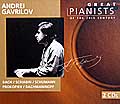 But this simplistic chronology is belied by his passionate 1993 Bach French Suite # 6 and a wistful 1973 Handel Suite in d minor. Rather, this program boasts brilliant virtuosity, constantly evolving and consistently serving the cause of a wide variety of music - a strongly characterized Chopin Ballade # 2, exciting Tchaikovsky Theme and Variations, a probing Mozart Fantasia in d minor, a potent Prokofiev Concerto # 1, rich Rachmaninov Moments Musicaux, a fiery Scriabin Sonata # 4 and wondrous excerpts from Prokofiev's Romeo and Juliet ballet, all capped by a stunning account of Balakirev's Islamey. The only curiosity is a weighty Schumann Papillons that emerges more as an iron butterfly than a dappled flight of imagination. Both in variety and execution, this is a breathtaking volume. But this simplistic chronology is belied by his passionate 1993 Bach French Suite # 6 and a wistful 1973 Handel Suite in d minor. Rather, this program boasts brilliant virtuosity, constantly evolving and consistently serving the cause of a wide variety of music - a strongly characterized Chopin Ballade # 2, exciting Tchaikovsky Theme and Variations, a probing Mozart Fantasia in d minor, a potent Prokofiev Concerto # 1, rich Rachmaninov Moments Musicaux, a fiery Scriabin Sonata # 4 and wondrous excerpts from Prokofiev's Romeo and Juliet ballet, all capped by a stunning account of Balakirev's Islamey. The only curiosity is a weighty Schumann Papillons that emerges more as an iron butterfly than a dappled flight of imagination. Both in variety and execution, this is a breathtaking volume.
- Walter Gieseking (1895-1956), Volume 1 - Although best remembered for his superlative Debussy and Ravel recordings (included in his volume 2, discussed below),
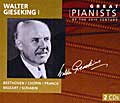 in his time Geiseking played an even more important role. Nowadays, Mozart has taken his rightful place alongside Bach and Beethoven as a supreme master, but barely a century ago nearly all his output beyond the late symphonies and operas were dismissed as rococo trivia. Gieseking’s pioneering LP traversal of Mozart’s complete solo piano music awakened much of the world to its splendor. While Gieseking’s mild interpretive approach seems somewhat attenuated in light of our modern view, in which we tend to attribute to Mozart a more expansive realm of human emotion, Gieseking presented Mozart with a simple sincerity that accorded him a respect that compelled reevaluation and led, in part, to his current esteem. The full cycle is readily available on EMI; instead, here we have his recordings with Karajan and the Philharmonia of the Piano Concertos 23 and 24, which (despite blurred, overloaded recordings) fully convey his clean classicism, treating Mozart neither as a budding romantic nor a precious miniaturist. Also here are the 1951 Karajan/Philharmonia Beethoven Concertos 4 and 5. The latter, in particular, serves as an ideal vehicle for Gieseking’s style, its exquisite adagio framed by the outer movements in which Beethoven lets his orchestra do the heavy lifting, leaving the soloist to revel in delicate adornment. Karajan provides an objective, emotionally-neutral backdrop in which Gieseking’s subtly expressive playing is effectively nestled. The same forces join in a dry and reticent Franck Symphonic Variations which seems bland compared to a number of more spirited accounts. in his time Geiseking played an even more important role. Nowadays, Mozart has taken his rightful place alongside Bach and Beethoven as a supreme master, but barely a century ago nearly all his output beyond the late symphonies and operas were dismissed as rococo trivia. Gieseking’s pioneering LP traversal of Mozart’s complete solo piano music awakened much of the world to its splendor. While Gieseking’s mild interpretive approach seems somewhat attenuated in light of our modern view, in which we tend to attribute to Mozart a more expansive realm of human emotion, Gieseking presented Mozart with a simple sincerity that accorded him a respect that compelled reevaluation and led, in part, to his current esteem. The full cycle is readily available on EMI; instead, here we have his recordings with Karajan and the Philharmonia of the Piano Concertos 23 and 24, which (despite blurred, overloaded recordings) fully convey his clean classicism, treating Mozart neither as a budding romantic nor a precious miniaturist. Also here are the 1951 Karajan/Philharmonia Beethoven Concertos 4 and 5. The latter, in particular, serves as an ideal vehicle for Gieseking’s style, its exquisite adagio framed by the outer movements in which Beethoven lets his orchestra do the heavy lifting, leaving the soloist to revel in delicate adornment. Karajan provides an objective, emotionally-neutral backdrop in which Gieseking’s subtly expressive playing is effectively nestled. The same forces join in a dry and reticent Franck Symphonic Variations which seems bland compared to a number of more spirited accounts.
- Walter Gieseking, Volume 2 - I'm deeply torn over this set. Artistically, it's consistently sensational and it ends with one of the greatest piano recordings
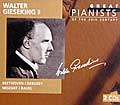 ever made - Gieseking's 1937/8 Ravel Gaspard de la Nuit. The exquisite subtlety of Gieseking's touch, the astounding color he conjures, and the sheer flow of his notes are absolutely breathtaking. And yet, much of the wonder is ruined by miserable transfers. In a sadly misguided (and largely unsuccessful) attempt to reduce the surface noise (of which plenty remains), the music is stripped of both bass and treble, leaving a boxy, synthetic sound that barely resembles a piano. Both the original LP transfer on Columbia ML 4773 and a prior CD on Pearl 9449 preserve the tonal richness and convey the depth of Gieseking's extraordinary sound. Such a shame! Equally lousy transfers diminish the marvels of Debussy's first book of Preludes and his Estampes. Swift and precise readings of the same vintage of Beethoven's Waldstein and Appassionata Sonatas come across somewhat better. If you can stand some increased "sizzle,"get the Pearl CD of the wondrous Debussy and Ravel. ever made - Gieseking's 1937/8 Ravel Gaspard de la Nuit. The exquisite subtlety of Gieseking's touch, the astounding color he conjures, and the sheer flow of his notes are absolutely breathtaking. And yet, much of the wonder is ruined by miserable transfers. In a sadly misguided (and largely unsuccessful) attempt to reduce the surface noise (of which plenty remains), the music is stripped of both bass and treble, leaving a boxy, synthetic sound that barely resembles a piano. Both the original LP transfer on Columbia ML 4773 and a prior CD on Pearl 9449 preserve the tonal richness and convey the depth of Gieseking's extraordinary sound. Such a shame! Equally lousy transfers diminish the marvels of Debussy's first book of Preludes and his Estampes. Swift and precise readings of the same vintage of Beethoven's Waldstein and Appassionata Sonatas come across somewhat better. If you can stand some increased "sizzle,"get the Pearl CD of the wondrous Debussy and Ravel.
- Emil Gilels (1916 - 1985), Volume 3 - The final volume devoted to the great Russian colossus emphasizes his lyric side. It begins with a 1972 account of the Brahms
 Second with Eugen Jochum and the Berlin Philharmonic that deliberately eschews the dramatic challenges of the work but reaches extraordinary expressive heights, especially in the ravishing andante (ironically the movement in which the piano plays the least role). There's also a rarely-heard Clementi Sonata and an intense and powerful account of the duo-piano Schubert Fantasy, D. 940 in which Gilels is partnered by his daughter Elena, who reinforces his full-blooded yet searching approach. Perhaps most fascinating, though, are the two Chopin Sonatas. Op. 35, from a 1961 concert, bristles with elemental energy and nervous tension, especially in Gilels' jagged shaping of the propulsive phrases of the first movement. Op. 58 (from 1978) begins with a burst of quirky passion but then subsides into a beautifully flowing, leisurely (30 minutes, rather than the usual 24 or so), autumnal discourse. Four gorgeous Grieg Lyric Pieces top off a wonderful tribute to a well-rounded and deeply sensitive artist. Second with Eugen Jochum and the Berlin Philharmonic that deliberately eschews the dramatic challenges of the work but reaches extraordinary expressive heights, especially in the ravishing andante (ironically the movement in which the piano plays the least role). There's also a rarely-heard Clementi Sonata and an intense and powerful account of the duo-piano Schubert Fantasy, D. 940 in which Gilels is partnered by his daughter Elena, who reinforces his full-blooded yet searching approach. Perhaps most fascinating, though, are the two Chopin Sonatas. Op. 35, from a 1961 concert, bristles with elemental energy and nervous tension, especially in Gilels' jagged shaping of the propulsive phrases of the first movement. Op. 58 (from 1978) begins with a burst of quirky passion but then subsides into a beautifully flowing, leisurely (30 minutes, rather than the usual 24 or so), autumnal discourse. Four gorgeous Grieg Lyric Pieces top off a wonderful tribute to a well-rounded and deeply sensitive artist.
- Grigory Ginsburg (1904 - 1961) - Heard after the brilliance of Gavrilov, this volume serves as a reminder that traditional Russian piano playing is not the blinding virtuosity
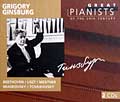 and thundering energy of Gilels, Richter or Horowitz, but a far more refined and contemplative style - a reflection of conservative Russian society before the Revolution, when ideals were far closer to European nobility than unleashed Slavic passion. Thus, in Ginsburg's hands Beethoven's explosive Rondo a capriccio in G, Op. 129, aptly titled the "Rage Over the Lost Penny," sounds more like Mozart annoyed than Beethoven in a fury. Ginsburg's grand style brings a fine sense of structural unfolding to six Liszt Hungarian Rhapsodies, Tchaikovsky's Grande Sonate in G, two transcriptions of Eugene Onegin and obscurities from Medtner and Miaskovsky. But don't mistake Ginsburg's approach for a masking of uncertain technique; the glissandi in his Hungarian Rhapsody # 10 are stunning and the Prokofiev Sonata # 3 is suitably brilliant. It just goes to show that sometimes smoldering embers can provide as much heat as a roaring blaze. and thundering energy of Gilels, Richter or Horowitz, but a far more refined and contemplative style - a reflection of conservative Russian society before the Revolution, when ideals were far closer to European nobility than unleashed Slavic passion. Thus, in Ginsburg's hands Beethoven's explosive Rondo a capriccio in G, Op. 129, aptly titled the "Rage Over the Lost Penny," sounds more like Mozart annoyed than Beethoven in a fury. Ginsburg's grand style brings a fine sense of structural unfolding to six Liszt Hungarian Rhapsodies, Tchaikovsky's Grande Sonate in G, two transcriptions of Eugene Onegin and obscurities from Medtner and Miaskovsky. But don't mistake Ginsburg's approach for a masking of uncertain technique; the glissandi in his Hungarian Rhapsody # 10 are stunning and the Prokofiev Sonata # 3 is suitably brilliant. It just goes to show that sometimes smoldering embers can provide as much heat as a roaring blaze.
- Leopold Godowsky (1870 - 1938) - Those who heard him in private considered Godowsky the greatest pianist of his generation, but he reportedly was intimidated by public
 performances and often sounds stiff on record. Indeed, the 12 Chopin Nocturnes heard here are charitably described in the liner notes as "earthbound," and that could be said as well of his Beethoven "Adieu" Sonata. The Schumann Carnival, Chopin Sonata # 2 and Grieg Ballade fare better, despite poor transfers; side 1 of the Grieg is badly damaged, unlike the transfer on Pearl 9133. Perhaps the finest piece is the Chopin Scherzo # 4, reconstituted from an acetate dub and a test pressing, in which, despite dreadful sound, Godowsky for once seems to catch fire and leave his inhibitions aside. But it's hard to separate one's reaction from the poignant circumstances of this recording - right after completing it, Godowsky suffered a stroke that ended his career; could he possibly have sensed that this might be his last performance? performances and often sounds stiff on record. Indeed, the 12 Chopin Nocturnes heard here are charitably described in the liner notes as "earthbound," and that could be said as well of his Beethoven "Adieu" Sonata. The Schumann Carnival, Chopin Sonata # 2 and Grieg Ballade fare better, despite poor transfers; side 1 of the Grieg is badly damaged, unlike the transfer on Pearl 9133. Perhaps the finest piece is the Chopin Scherzo # 4, reconstituted from an acetate dub and a test pressing, in which, despite dreadful sound, Godowsky for once seems to catch fire and leave his inhibitions aside. But it's hard to separate one's reaction from the poignant circumstances of this recording - right after completing it, Godowsky suffered a stroke that ended his career; could he possibly have sensed that this might be his last performance?
- Glenn Gould (1932 - 1982) - Here's a bizarre collection. Gould had a reputation as one of the most eccentric pianists, but somehow I don't think the producers programmed Gould's
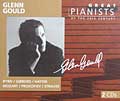 volume with Byrd, Gibbons, Scarlatti, Bizet, Strauss and Berg as a salute to his artistic personality. Gould was arguably the most important Bach player of all time. His deeply personal ideas were both praised as brilliant and reviled as perverse but never ignored. Here, though, they are wholly ignored -- we get not a note of his Bach (or even his equally controversial Beethoven). Rather, his volume is filled with throwaway stuff peripheral to his artistry. The liner notes forthrightly acnowledge this gaping lapse and gallantly try to infer Gould's greatness from bare hints derived from the stuff that's included. But why? I can only assume that the licensing process here fell more than a bit short of the love-fest of cooperation suggested by the publicity surrounding the Edition. I suspect that Sony, for one, kept all the best Gould material for its own recently-completed Glenn Gould Edition (which, incidentally, is a huge ripoff, full-priced but with many of its discs barely half full). It's also worth noting that the only two artists absent from the sampler volume of this Edition are Gould and his Sony label-mate Rudolf Serkin, and that according to the intended release schedule printed in the sampler Gould was to have had two volumes, but one of his two numbers was later reassigned to Gieseking. volume with Byrd, Gibbons, Scarlatti, Bizet, Strauss and Berg as a salute to his artistic personality. Gould was arguably the most important Bach player of all time. His deeply personal ideas were both praised as brilliant and reviled as perverse but never ignored. Here, though, they are wholly ignored -- we get not a note of his Bach (or even his equally controversial Beethoven). Rather, his volume is filled with throwaway stuff peripheral to his artistry. The liner notes forthrightly acnowledge this gaping lapse and gallantly try to infer Gould's greatness from bare hints derived from the stuff that's included. But why? I can only assume that the licensing process here fell more than a bit short of the love-fest of cooperation suggested by the publicity surrounding the Edition. I suspect that Sony, for one, kept all the best Gould material for its own recently-completed Glenn Gould Edition (which, incidentally, is a huge ripoff, full-priced but with many of its discs barely half full). It's also worth noting that the only two artists absent from the sampler volume of this Edition are Gould and his Sony label-mate Rudolf Serkin, and that according to the intended release schedule printed in the sampler Gould was to have had two volumes, but one of his two numbers was later reassigned to Gieseking.
- Frederich Gulda (b. 1930), volume 2 - The turgid excerpt in the sampler scared me away from his first, all-Debussy and Ravel volume. Here, though, are extraordinary performances -
 solidly classical but with brilliant touches of individuality. The Chopin Ballades are incredible, fast but not rushed and filled with invention and life. The Beethoven and Chopin Concertos # 1 boast chamber sonorities, decades ahead of modern, "authentic" versions. The liner notes, though, constantly tease with anticipation of the really great phase of Gulda's artistry that they claim would follow these ‘fifties records. Since Gulda isn't exactly a household name here in the Colonies, I'd like to have heard some of his real glories, but they're nowhere to be heard. The set concludes with a six-minute live jam with an unidentified jazz combo. Are the producers suggesting that jazz is a natural extension of traditional classical music (as indeed it is)? If so, then lots of other great pianists of the twentieth century beg to be included in future volumes - Jellyroll Morton, Fats Waller, Art Tatum, Erroll Garner, ... solidly classical but with brilliant touches of individuality. The Chopin Ballades are incredible, fast but not rushed and filled with invention and life. The Beethoven and Chopin Concertos # 1 boast chamber sonorities, decades ahead of modern, "authentic" versions. The liner notes, though, constantly tease with anticipation of the really great phase of Gulda's artistry that they claim would follow these ‘fifties records. Since Gulda isn't exactly a household name here in the Colonies, I'd like to have heard some of his real glories, but they're nowhere to be heard. The set concludes with a six-minute live jam with an unidentified jazz combo. Are the producers suggesting that jazz is a natural extension of traditional classical music (as indeed it is)? If so, then lots of other great pianists of the twentieth century beg to be included in future volumes - Jellyroll Morton, Fats Waller, Art Tatum, Erroll Garner, ...
- Clara Haskil (1895 - 1960) - It's hard to avoid the temptation to relate Clara Haskil's art to her difficult life. Yet, her tribulations (spine injuries, brain tumor, exile) led her playing along two diametrically opposed courses.
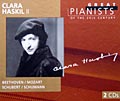 Peter Cosse, in his notes to the first of Haskil's two volumes here, claims that her tribulations purified her outlook down to essentials. Indeed, she doesn't try to burden essentially sunny or naive works with a depth they don't contain. Thus, her Schumann (the "ABEGG" Variations and Kinderszenen) and major-key Mozart (the "Ah, vous dirai-je Maman" and "Duport" Variations, Concertos 13, 23 and 27 and Sonatas K 330 and 280) are simple and lovely, with the adagio of the latter exquisite not through delicacy but breathtaking dynamic control. Yet, her afflictions also led to profound insight in works that probe more deeply into the human condition, which she charges with an undercurrent of malaise, largely through disquieting rhythmic irregularity and cautious tonal coloring. Her Mozart Concertos # 20 in d minor and # 24 in c minor with Igor Markevitch conducting the Lamoureux Concert Orchestra the month of her death (she was injured by a fall, so we can't infer premonitions of mortality from the timing), fully reflect the mature Mozart - no overt bitterness or melodramatic distress, but rather the gentlest hint of sadness beneath joy and hesitation behind celebration. Her Beethoven Sonatas 17 ("Tempest") and 18 open with the subtlest of stirrings beneath the surface, and culminate in finales tinged with oppressive labor. Equally effective is her Schubert Sonata in B flat, D 960, with a gingerly opening that prepares for uncertain prospects, a scherzo rushed and quirky and a finale far too quick to provide a satisfying conclusion. Her ultimate message seems as ambiguous as life itself. Karl Schumann described her as "dematerialized and free from anything in the least earthy, ... belonging to a different, spiritual world." Peter Cosse, in his notes to the first of Haskil's two volumes here, claims that her tribulations purified her outlook down to essentials. Indeed, she doesn't try to burden essentially sunny or naive works with a depth they don't contain. Thus, her Schumann (the "ABEGG" Variations and Kinderszenen) and major-key Mozart (the "Ah, vous dirai-je Maman" and "Duport" Variations, Concertos 13, 23 and 27 and Sonatas K 330 and 280) are simple and lovely, with the adagio of the latter exquisite not through delicacy but breathtaking dynamic control. Yet, her afflictions also led to profound insight in works that probe more deeply into the human condition, which she charges with an undercurrent of malaise, largely through disquieting rhythmic irregularity and cautious tonal coloring. Her Mozart Concertos # 20 in d minor and # 24 in c minor with Igor Markevitch conducting the Lamoureux Concert Orchestra the month of her death (she was injured by a fall, so we can't infer premonitions of mortality from the timing), fully reflect the mature Mozart - no overt bitterness or melodramatic distress, but rather the gentlest hint of sadness beneath joy and hesitation behind celebration. Her Beethoven Sonatas 17 ("Tempest") and 18 open with the subtlest of stirrings beneath the surface, and culminate in finales tinged with oppressive labor. Equally effective is her Schubert Sonata in B flat, D 960, with a gingerly opening that prepares for uncertain prospects, a scherzo rushed and quirky and a finale far too quick to provide a satisfying conclusion. Her ultimate message seems as ambiguous as life itself. Karl Schumann described her as "dematerialized and free from anything in the least earthy, ... belonging to a different, spiritual world."
Myra Hess (1890 - 1965) - Modern memories of Myra Hess tend to focus upon her unstinting service to her country in World War II, when she organized 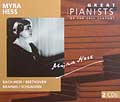 and participated in over a thousand concerts to boost British morale. This set memorializes her equally important service to her art. Hess's reputation was as a deeply serious artist, and at first her records seem uninspired and prosaic. But still waters do run deep and once her dignity and emotional reticence are accepted, they subtly radiate the profound peace and inner contentment of a mature master. Over half this volume is devoted to her superb Schumann. Her Etudes Symphoniques are dark and brooding, deeply burnished, with muted energy constantly smoldering beneath the surface. Her 1938 Carnival and an LP remake of the Concerto forego their inherent playfulness for autumnal gentleness and poetic restraint. (The notes attribute part of this to her aversion to recording, and indeed a contemporaneous live recording of the Concerto with Mitropoulos on AS Disc 627 is more inflected. But the intellectual and emotional control of her studio records creates their own power.) Her cerebral and magisterial approach crafts profound, beautifully-shaped and deeply moving experiences of two late Beethoven sonatas (Op. 109 and 110). But this otherwise fine celebration of a national and musical icon ends on a doleful note, with a stilted and cranky 1957 remake of her celebrated signature arrangement of Bach's Jesu, Joy of Man's Desiring, whose crude dynamics and insecure rhythms are a cruel echo of her devout 1940 HMV version (available on Biddulph 025). and participated in over a thousand concerts to boost British morale. This set memorializes her equally important service to her art. Hess's reputation was as a deeply serious artist, and at first her records seem uninspired and prosaic. But still waters do run deep and once her dignity and emotional reticence are accepted, they subtly radiate the profound peace and inner contentment of a mature master. Over half this volume is devoted to her superb Schumann. Her Etudes Symphoniques are dark and brooding, deeply burnished, with muted energy constantly smoldering beneath the surface. Her 1938 Carnival and an LP remake of the Concerto forego their inherent playfulness for autumnal gentleness and poetic restraint. (The notes attribute part of this to her aversion to recording, and indeed a contemporaneous live recording of the Concerto with Mitropoulos on AS Disc 627 is more inflected. But the intellectual and emotional control of her studio records creates their own power.) Her cerebral and magisterial approach crafts profound, beautifully-shaped and deeply moving experiences of two late Beethoven sonatas (Op. 109 and 110). But this otherwise fine celebration of a national and musical icon ends on a doleful note, with a stilted and cranky 1957 remake of her celebrated signature arrangement of Bach's Jesu, Joy of Man's Desiring, whose crude dynamics and insecure rhythms are a cruel echo of her devout 1940 HMV version (available on Biddulph 025).
- Josef Hofmann (1876 - 1957) - The label sticker boasts that this set contains the bulk of Hofmann's approved recordings. That may be true,
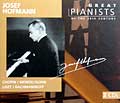 but it's an unfortunate one-sided portrait - literally, since nearly all consist of single 78-sided encores. They're marvelous in small doses, but hearing the entire set is something like making a two-hour meal out of nothing but hors d'oeuvres. Even so, the exquisite refinement, superb control and flawless technique that made Hofmann a pioneer of modern objectivity all manage to burst through the limitations of the acoustical process. Even the earliest (1903) are surprisingly effective, transcending the artificial demands, limited fidelity and compressed dynamics of the recordings. Beyond salon fluff ("Birds at Dawn"), there's some magnificent Mendelssohn, Liszt, Chopin, Scarlatti, Rachmaninoff and Moszkowski that display the refined purity of Hofmann's art. Most extraordinary is a double-sided Liszt Hungarian Rhapsody # 2 that hints at more emotional heat found in Hofmann's later, albeit "unapproved," recordings, now on VAI and Marston CDs. Perhaps the most memorable of all was the legendary November 28, 1937 concert marking the 50th anniversary of his Carnegie Hall debut. Electrified with a sensitivity and energy that eludes the studio sides, Hofmann gave stunning readings of the Rubinstein Concerto # 4, which he played in 189x following two years of study with the composer, his own neoromantic Chromaticon, a Chopin set and encores, ending with a Moszkowski Spanish Rhapsody with seemingly more wrong notes than right, and yet of overwhelming brilliance and power - a sensational tribute to his artistry. but it's an unfortunate one-sided portrait - literally, since nearly all consist of single 78-sided encores. They're marvelous in small doses, but hearing the entire set is something like making a two-hour meal out of nothing but hors d'oeuvres. Even so, the exquisite refinement, superb control and flawless technique that made Hofmann a pioneer of modern objectivity all manage to burst through the limitations of the acoustical process. Even the earliest (1903) are surprisingly effective, transcending the artificial demands, limited fidelity and compressed dynamics of the recordings. Beyond salon fluff ("Birds at Dawn"), there's some magnificent Mendelssohn, Liszt, Chopin, Scarlatti, Rachmaninoff and Moszkowski that display the refined purity of Hofmann's art. Most extraordinary is a double-sided Liszt Hungarian Rhapsody # 2 that hints at more emotional heat found in Hofmann's later, albeit "unapproved," recordings, now on VAI and Marston CDs. Perhaps the most memorable of all was the legendary November 28, 1937 concert marking the 50th anniversary of his Carnegie Hall debut. Electrified with a sensitivity and energy that eludes the studio sides, Hofmann gave stunning readings of the Rubinstein Concerto # 4, which he played in 189x following two years of study with the composer, his own neoromantic Chromaticon, a Chopin set and encores, ending with a Moszkowski Spanish Rhapsody with seemingly more wrong notes than right, and yet of overwhelming brilliance and power - a sensational tribute to his artistry.
- Vladimir Horowitz (1903 - 1989), volume 3 - A pleasant surprise. In lieu of the redundant Brahms and Tchaikovsky concertos originally scheduled, the producers have substituted
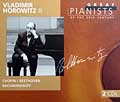 a full disc of Chopin Etudes, Mazurkas, the Barcarolle and the "Heroic" Polonaise. Five pieces are given in two versions - EMIs from the early ‘thirties and RCA remakes from the late ‘forties. The readings are essentially similar, but serve to demonstrate the artist's evolution from driven, pointed early impulse to a more self-conscious display of bravura technique. The other disc contains two essential concerto recordings with Reiner and the RCA Symphony. The 1952 Beethoven Emperor is a perfect melding of temperaments of conductor and soloist to produce a clean, propulsive reading of a masterwork that sounds just fine as pure music, unencumbered by interpretive rhetoric. The 1951 "Rach 3" lacks the unabashed fire of the legendary 1930 Horowitz/Coates version but projects a confident swagger that nearly matches the authority of the composer's own 1940 recording with Ormandy. a full disc of Chopin Etudes, Mazurkas, the Barcarolle and the "Heroic" Polonaise. Five pieces are given in two versions - EMIs from the early ‘thirties and RCA remakes from the late ‘forties. The readings are essentially similar, but serve to demonstrate the artist's evolution from driven, pointed early impulse to a more self-conscious display of bravura technique. The other disc contains two essential concerto recordings with Reiner and the RCA Symphony. The 1952 Beethoven Emperor is a perfect melding of temperaments of conductor and soloist to produce a clean, propulsive reading of a masterwork that sounds just fine as pure music, unencumbered by interpretive rhetoric. The 1951 "Rach 3" lacks the unabashed fire of the legendary 1930 Horowitz/Coates version but projects a confident swagger that nearly matches the authority of the composer's own 1940 recording with Ormandy.
- William Kapell (1922 - 1953) - In thinking of Kapell, it's so hard to avoid dwelling on regret over what might have been, had he not been killed in an air crash
 at age 31, his creative adulthood barely begun. It's clear from the records he left us that he would have been a preeminent pianist of our time. True believers will already have obtained RCA/BMG's complete 9-CD Kapell collection last year, but this volume provides a nice introduction for the unconverted. The solos on the second disc range from an electrifying 1945 Liszt Mephisto Waltz, bursting with coiled tension, to a deeply human 1953 Bach Partita # 4, meticulously recorded over four days. His Albeniz Evocacion is subtly atmospheric, his Liszt Sonetto 104 del Petrarca and Hungarian Rhapsody # 11 are scintillating, and his Chopin Sonata # 3 is a marvelous synthesis of power and lyricism. The first disc is devoted to the big, splashy orchestral works of his early fame, each superbly accompanied by a sympathetic conductor - the Rachmaninoff Concerto # 2 (Steinberg) and Rhapsody on a Theme by Paganini (Reiner) and the Prokofiev Concerto # 3 (Dorati). But, fine as these overly-familiar works are, it seems a shame to have omitted Kapell's seminal recording with Koussevitzky of the Khachaturian Piano Concerto or, for that matter, his Beethoven Second with Golschmann, both of which he championed but neither of which are otherwise represented in this series. at age 31, his creative adulthood barely begun. It's clear from the records he left us that he would have been a preeminent pianist of our time. True believers will already have obtained RCA/BMG's complete 9-CD Kapell collection last year, but this volume provides a nice introduction for the unconverted. The solos on the second disc range from an electrifying 1945 Liszt Mephisto Waltz, bursting with coiled tension, to a deeply human 1953 Bach Partita # 4, meticulously recorded over four days. His Albeniz Evocacion is subtly atmospheric, his Liszt Sonetto 104 del Petrarca and Hungarian Rhapsody # 11 are scintillating, and his Chopin Sonata # 3 is a marvelous synthesis of power and lyricism. The first disc is devoted to the big, splashy orchestral works of his early fame, each superbly accompanied by a sympathetic conductor - the Rachmaninoff Concerto # 2 (Steinberg) and Rhapsody on a Theme by Paganini (Reiner) and the Prokofiev Concerto # 3 (Dorati). But, fine as these overly-familiar works are, it seems a shame to have omitted Kapell's seminal recording with Koussevitzky of the Khachaturian Piano Concerto or, for that matter, his Beethoven Second with Golschmann, both of which he championed but neither of which are otherwise represented in this series.
- Julius Katchen (1926 - 1969), volume 2 - Similar thoughts are conjured here. The notes by Hyperion Knight salute Katchen’s stamina and diverse repertoire before his life was cut short at age 42, cruelly denying him an artist’s privilege of settling into the reflective pace of an old master.
 The first volume features his solo work, consistent with his extensive European career among audiences he found more sophisticated than in his native America and highlights his Brahms, of which he recorded a pioneering and highly acclaimed cycle. Here, though, are concerted pieces, mostly bright and flashy. Beethoven’s Rondo in B-flat, WoO 6, conducted by Piero Gamba, is sheer delight, displaying both the composer’s and performer’s youthful exhuberance. Rachmaninoff’s Rhapsody on a Theme by Paganini, Liszt’s Concerto # 2 and Ravel’s Piano Concerto in G are all fine. (Donnanyi’s vapid Variations on a Nursury Tune gets a far better performance than it deserves; Knight describes it as an interesting clash and reconciliation between Wagnerian orchestration and Mozartean solos, but I think of it less charitably; to paraphrase Charles Ives, a perfect depiction of a bad odor can be admired, but it still stinks.) Three performances, though, are of stunning brilliance – the Ravel Concerto for the Left Hand, the Prokofiev Concerto # 3 and especially a spectacular Gershwin Rhapsody in Blue, in which Katchen tosses off the solos with astoundingly fleet unbridled energy, often leaping ahead of the sharply accented accompaniment that constantly reveals detailed threads amid the multi-textured orchestral fabric. All were recorded with conductor Istvan Kertesz in November 1968. The date seems highly significant, as Katchen already was ill with incurable leukemia to which he would succumb within months. (Ironically, Kertesz would die soon thereafter at age 43, although from drowning, and so without premonition.) Perhaps – no, probably – Katchen knew that these recordings were apt to be his last and so he had to ensure that they would frame his legacy with a worthy remembrance of a career of which we can only imagine the lost second half from the glory of his final records. The first volume features his solo work, consistent with his extensive European career among audiences he found more sophisticated than in his native America and highlights his Brahms, of which he recorded a pioneering and highly acclaimed cycle. Here, though, are concerted pieces, mostly bright and flashy. Beethoven’s Rondo in B-flat, WoO 6, conducted by Piero Gamba, is sheer delight, displaying both the composer’s and performer’s youthful exhuberance. Rachmaninoff’s Rhapsody on a Theme by Paganini, Liszt’s Concerto # 2 and Ravel’s Piano Concerto in G are all fine. (Donnanyi’s vapid Variations on a Nursury Tune gets a far better performance than it deserves; Knight describes it as an interesting clash and reconciliation between Wagnerian orchestration and Mozartean solos, but I think of it less charitably; to paraphrase Charles Ives, a perfect depiction of a bad odor can be admired, but it still stinks.) Three performances, though, are of stunning brilliance – the Ravel Concerto for the Left Hand, the Prokofiev Concerto # 3 and especially a spectacular Gershwin Rhapsody in Blue, in which Katchen tosses off the solos with astoundingly fleet unbridled energy, often leaping ahead of the sharply accented accompaniment that constantly reveals detailed threads amid the multi-textured orchestral fabric. All were recorded with conductor Istvan Kertesz in November 1968. The date seems highly significant, as Katchen already was ill with incurable leukemia to which he would succumb within months. (Ironically, Kertesz would die soon thereafter at age 43, although from drowning, and so without premonition.) Perhaps – no, probably – Katchen knew that these recordings were apt to be his last and so he had to ensure that they would frame his legacy with a worthy remembrance of a career of which we can only imagine the lost second half from the glory of his final records.
- Wilhelm Kempff (1895 - 1991), volume 3 - Kempff should be cherished by record collectors for his pioneering integral sets of Beethoven, Schubert, Schumann and Brahms piano works,
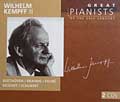 long before such projects became commonplace. Kempff's first two volumes in this series focussed on his somewhat bland Brahms and Liszt. Here, we have a fine overview of his art, in which he subsumed his personality to produce idiomatic readings of the core German repertoire, with structure and intellect overriding emotion and color. The program is creative and avoids overlap with other artists' volumes. Thus, in lieu of more popular fare, we get Mozart's Concerto # 8 in C, Brahms's Two Rhapsodies, Op. 79, Beethoven's Sonatas #s 2 and 11, Schubert's "Unfinished" Sonata in C, D. 840 and Schumann's Three Romances, Op. 28. The set concludes with a great surprise reminiscent of Gieseking - Faure's Nocturne # 6 in a quintessentially Gallic reading from a quintessentially German artist. While lacking the individuality of the golden age pianists or some of our modern iconoclasts, Kempff's artistry, in the right repertoire, is deeply satisfying and always seeped in artistic integrity. long before such projects became commonplace. Kempff's first two volumes in this series focussed on his somewhat bland Brahms and Liszt. Here, we have a fine overview of his art, in which he subsumed his personality to produce idiomatic readings of the core German repertoire, with structure and intellect overriding emotion and color. The program is creative and avoids overlap with other artists' volumes. Thus, in lieu of more popular fare, we get Mozart's Concerto # 8 in C, Brahms's Two Rhapsodies, Op. 79, Beethoven's Sonatas #s 2 and 11, Schubert's "Unfinished" Sonata in C, D. 840 and Schumann's Three Romances, Op. 28. The set concludes with a great surprise reminiscent of Gieseking - Faure's Nocturne # 6 in a quintessentially Gallic reading from a quintessentially German artist. While lacking the individuality of the golden age pianists or some of our modern iconoclasts, Kempff's artistry, in the right repertoire, is deeply satisfying and always seeped in artistic integrity.
- Evgeny Kissin (b. 1971) - While prodigies are sufficiently rare to generate awe, the Great Pianists edition spoils us, as nearly all the artists’ bios begin the same way –
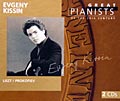 their talents were discovered quite young, they dazzled their seniors, won prestigious contests and developed into early career successes that deepened as they aged. Even among such eminent company, Kissin well merits the ecstatic reviews he has consistently garnered. Yet, as the album notes recall, Kissin is somewhat unique in that he never won, much less entered, a single major piano competition. He didn’t have to – hearing any of his studio or concert recordings immediately proves his immense talent. The youngest of the pianists in this Edition, his earliest recordings here were made at age 13, and his “mature” ones a mere decade later. All astound with their staggering technique, not only for their sheer virtuosity and phenomenal precision, but for the variety of tone and dynamics, the unrelieved concentration and the tension that arises from the restraint of knowing when to unleash reserves of enormous power and when to hold it under control. Yet, the collection presented here isn’t fully satisfying as it falls short of a complete picture of the artist. The first disc is all-Liszt. While it affords a fine showcase for technical display (as in the dazzling opener, the Hungarian Rhapsody # 12), there’s little of substance to afford Kissin an opportunity to apply his awesome, confident technique to communicate a deeper meaning beneath the surface; the main prospect – the Harmonies du soir (from the Études d’exécution transcendante) – merely hints at profundity and not much materializes beyond glorious sound. The second disc is Prokofiev. While the accompaniment by Abbado and the Berlin Philharmonic fits ideally, the Piano Concerto # 3 is surprisingly placid. The Piano Sonata # 6 seems more idiomatic, as Kissin manages to balance percussive precision without trivializing its essential heaviness and wraps it up with demonic intensity. The Overture on Hebrew Themes, a pastiche hurriedly written for an ensemble of former classmates during Prokofiev’s American visit, is a welcome rarity, but a curious choice, as the piano is called upon for only a minimal contribution. Frankly, I would have preferred some of Kissin’s acclaimed Chopin and Rachmaninoff as a fuller picture of his talent. their talents were discovered quite young, they dazzled their seniors, won prestigious contests and developed into early career successes that deepened as they aged. Even among such eminent company, Kissin well merits the ecstatic reviews he has consistently garnered. Yet, as the album notes recall, Kissin is somewhat unique in that he never won, much less entered, a single major piano competition. He didn’t have to – hearing any of his studio or concert recordings immediately proves his immense talent. The youngest of the pianists in this Edition, his earliest recordings here were made at age 13, and his “mature” ones a mere decade later. All astound with their staggering technique, not only for their sheer virtuosity and phenomenal precision, but for the variety of tone and dynamics, the unrelieved concentration and the tension that arises from the restraint of knowing when to unleash reserves of enormous power and when to hold it under control. Yet, the collection presented here isn’t fully satisfying as it falls short of a complete picture of the artist. The first disc is all-Liszt. While it affords a fine showcase for technical display (as in the dazzling opener, the Hungarian Rhapsody # 12), there’s little of substance to afford Kissin an opportunity to apply his awesome, confident technique to communicate a deeper meaning beneath the surface; the main prospect – the Harmonies du soir (from the Études d’exécution transcendante) – merely hints at profundity and not much materializes beyond glorious sound. The second disc is Prokofiev. While the accompaniment by Abbado and the Berlin Philharmonic fits ideally, the Piano Concerto # 3 is surprisingly placid. The Piano Sonata # 6 seems more idiomatic, as Kissin manages to balance percussive precision without trivializing its essential heaviness and wraps it up with demonic intensity. The Overture on Hebrew Themes, a pastiche hurriedly written for an ensemble of former classmates during Prokofiev’s American visit, is a welcome rarity, but a curious choice, as the piano is called upon for only a minimal contribution. Frankly, I would have preferred some of Kissin’s acclaimed Chopin and Rachmaninoff as a fuller picture of his talent.
- Stephen Kovacevich (b. 1940), volume 2 - His first volume was all-Beethoven; this one presents a more balanced program. The most astounding performance is a blistering,
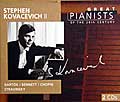 driven account of the Bartok Piano Concerto # 2 which makes the classic Anda/Fricsay version (also in the Great Pianists edition) sound downright romantic. Kovacevich brings the same clear, energetic, thoughtful precision to his Beethoven, Chopin and Brahms. This is one of the very few volumes of the entire Great Pianists series that delves into modern music, including fine versions of Stravinsky's Concerto for Piano and Wind Instruments, Bartok's Out of Doors and Sonatina, and Richard Rodney Bennett's powerful 1968 Piano Concerto # 1, written for Kovacevich and custom suited to his temperament and technical facility. driven account of the Bartok Piano Concerto # 2 which makes the classic Anda/Fricsay version (also in the Great Pianists edition) sound downright romantic. Kovacevich brings the same clear, energetic, thoughtful precision to his Beethoven, Chopin and Brahms. This is one of the very few volumes of the entire Great Pianists series that delves into modern music, including fine versions of Stravinsky's Concerto for Piano and Wind Instruments, Bartok's Out of Doors and Sonatina, and Richard Rodney Bennett's powerful 1968 Piano Concerto # 1, written for Kovacevich and custom suited to his temperament and technical facility.
- Alicia de Larrocha (b. 1923), volume 2 - There's something about the bright Iberian sun that charges artists with a clarifying vision; it boosted Cervantes,
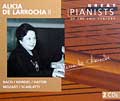 Picasso and others to a level of transcendent insight, all while retaining an earthy naturalness, and it seems to have done the same for Alicia de Larrocha. The sole ambassador of Spain in this collection, her first volume was filled with readings of Albinez and other compatriots that were striking for their unpretentious clarity. Here, she casts a similar lucid eye to the baroque and classical repertoire which share much of the fundamental outlook of her countrymen. A whole disc is devoted to Mozart - the Sonatas, K. 310, 330, 331 and 576, and the Rondo in D, K. 485. All are sharp but never brittle, pointed yet comfortable, subtly implying depth without destroying their classical innocence. The same can be said for the Haydn Andante con variazioni in f minor and Handel "Harmonious Blacksmith" Suite. Her Scarlatti sonatas and Bach Italian Concerto and French Suite # 6, too, achieve a beautiful balance of courtly grace and life-affirming elan. Picasso and others to a level of transcendent insight, all while retaining an earthy naturalness, and it seems to have done the same for Alicia de Larrocha. The sole ambassador of Spain in this collection, her first volume was filled with readings of Albinez and other compatriots that were striking for their unpretentious clarity. Here, she casts a similar lucid eye to the baroque and classical repertoire which share much of the fundamental outlook of her countrymen. A whole disc is devoted to Mozart - the Sonatas, K. 310, 330, 331 and 576, and the Rondo in D, K. 485. All are sharp but never brittle, pointed yet comfortable, subtly implying depth without destroying their classical innocence. The same can be said for the Haydn Andante con variazioni in f minor and Handel "Harmonious Blacksmith" Suite. Her Scarlatti sonatas and Bach Italian Concerto and French Suite # 6, too, achieve a beautiful balance of courtly grace and life-affirming elan.
- Josef Lhevinne (1874 - 1944) and Rosina Lhevinne (1880 - 1976) - In a way, this set delivers three artists. The first is Josef Lhevinne, who had a reputation as a complete musician with a deeply sensitive command of the keyboard.
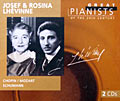 Unfortunately, he made few recordings, but they're all wonderful, displaying solid and often startling technique with natural expression that transforms any piece into an unforgettable experience, from the simple charm of Beethoven's Ecossaises, an astonishingly fast Tchaikovsky Trepak, an uncommonly serious Schumann Toccata, a gossamer Chopin Etude in g-sharp minor, a bold, propulsive Chopin "Heroic" Polonaise, and the exhilarating yet graceful blizzard of notes of the Strauss/Schulz-Evan Arabesques on "An der schonen, blauen Donau." The second disc presents his wife Rosina, a famous teacher in her own right, but rarely mentioned as a performer. Her Mozart Concerto # 21 (superbly accompanied by the Julliard Orchestra conducted by Jean Morel) and Chopin Concerto # 1 (with an equally fine Alumni of the National Orchestral Association led by John Barnett) are hugely self-assured, with crisp but yielding rhythms and vital, beautifully nuanced phrasing. But perhaps the greatest miracle is that these fabulous recordings were both made in 1961, when she was 81 years old! Fortunately, the Lhevinnes combined for two 1939 recordings. The Mozart Sonata for Two Pianos is classically restrained, but tempered with just the right dash of expressive seasoning. Apparently having some time left in that session, they launched into a single take of Ravel's two-piano arrangement of Debussy's Fetes, a stunning display of four hands and two kindred souls. Unfortunately, he made few recordings, but they're all wonderful, displaying solid and often startling technique with natural expression that transforms any piece into an unforgettable experience, from the simple charm of Beethoven's Ecossaises, an astonishingly fast Tchaikovsky Trepak, an uncommonly serious Schumann Toccata, a gossamer Chopin Etude in g-sharp minor, a bold, propulsive Chopin "Heroic" Polonaise, and the exhilarating yet graceful blizzard of notes of the Strauss/Schulz-Evan Arabesques on "An der schonen, blauen Donau." The second disc presents his wife Rosina, a famous teacher in her own right, but rarely mentioned as a performer. Her Mozart Concerto # 21 (superbly accompanied by the Julliard Orchestra conducted by Jean Morel) and Chopin Concerto # 1 (with an equally fine Alumni of the National Orchestral Association led by John Barnett) are hugely self-assured, with crisp but yielding rhythms and vital, beautifully nuanced phrasing. But perhaps the greatest miracle is that these fabulous recordings were both made in 1961, when she was 81 years old! Fortunately, the Lhevinnes combined for two 1939 recordings. The Mozart Sonata for Two Pianos is classically restrained, but tempered with just the right dash of expressive seasoning. Apparently having some time left in that session, they launched into a single take of Ravel's two-piano arrangement of Debussy's Fetes, a stunning display of four hands and two kindred souls.
- Nikita Magaloff (1912 - 1992) - Perhaps it's really a tribute to the richness of the Great Pianists Edition and how deeply spoiled I've become from exposure
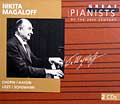 to the consistent excellence of its performances, but the prospect of another Chopin recital was less than electrifying, especially from an artist better known for his elegance, nobility and technical refinement than for bold stylization or probing insight. Even so, the second disc here is a real grabber, simply because it bypasses well-worn Chopin favorites for such rarities as the First Sonata, Allegro de concert, Bolero, Tarantelle, Ecossaises, Rondo a la Mazur and Variations brillantes. Together with a Haydn sonata and Liszt's Six Paganini Etudes on the first disc, they're all welcome as a refreshing break from the repetitive programming that has dulled much of the initial enthusiasm (and, I understand, sales) generated by the earlier releases. (OK - there's also (yawn!) another Schumann Carnival.) Here's my plea to the producers: if this series is to continue, please dig deeper into the archives for more adventurous programming, rather than just more and more and more of the same standard stuff. Make this a voyage of discovery, not only of performing style but of repertoire as well. to the consistent excellence of its performances, but the prospect of another Chopin recital was less than electrifying, especially from an artist better known for his elegance, nobility and technical refinement than for bold stylization or probing insight. Even so, the second disc here is a real grabber, simply because it bypasses well-worn Chopin favorites for such rarities as the First Sonata, Allegro de concert, Bolero, Tarantelle, Ecossaises, Rondo a la Mazur and Variations brillantes. Together with a Haydn sonata and Liszt's Six Paganini Etudes on the first disc, they're all welcome as a refreshing break from the repetitive programming that has dulled much of the initial enthusiasm (and, I understand, sales) generated by the earlier releases. (OK - there's also (yawn!) another Schumann Carnival.) Here's my plea to the producers: if this series is to continue, please dig deeper into the archives for more adventurous programming, rather than just more and more and more of the same standard stuff. Make this a voyage of discovery, not only of performing style but of repertoire as well.
- Arturo Benedetti Michelangeli (1920 - 1995), volume 2 - Whether or not he was the greatest pianist of his time, as some have claimed, Michelangeli surely was one of the least
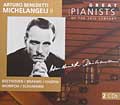 conventional and most controversial. With a repertoire narrower than some one-hit oldies groups and a reputation for bailing out of concerts worse than many temperamental rock stars, Michelangeli constantly fascinates by teasing expectations. His Brahms Paganini Variations are cut and scrambled (possibly to squeeze onto four 78 rpm sides) yet magnificent, Beethoven's Sonata # 4 is drained of its accustomed rhythmic elan, Schumann's Carnival is both deliberate (31 ½ minutes, as opposed to Rachmaninoff's 23 and Godowsky's 24) and disrupts the flow with long, melodramatic pauses between movements, excerpts from Schumann's Album fur die Jugend reflect more autumnal deliberation than youthful frolic, and ten Chopin Mazurkas and the Brahms Ballades, Op. 10 are deeply atmospheric and mystical. Wonderful, challenging stuff, and a welcome throwback to the days when artists' whims reigned supreme. conventional and most controversial. With a repertoire narrower than some one-hit oldies groups and a reputation for bailing out of concerts worse than many temperamental rock stars, Michelangeli constantly fascinates by teasing expectations. His Brahms Paganini Variations are cut and scrambled (possibly to squeeze onto four 78 rpm sides) yet magnificent, Beethoven's Sonata # 4 is drained of its accustomed rhythmic elan, Schumann's Carnival is both deliberate (31 ½ minutes, as opposed to Rachmaninoff's 23 and Godowsky's 24) and disrupts the flow with long, melodramatic pauses between movements, excerpts from Schumann's Album fur die Jugend reflect more autumnal deliberation than youthful frolic, and ten Chopin Mazurkas and the Brahms Ballades, Op. 10 are deeply atmospheric and mystical. Wonderful, challenging stuff, and a welcome throwback to the days when artists' whims reigned supreme.
- Benno Moiseiwitsch (1890 - 1963) - Although born in Russia, after being expelled from school Moiseiwitsch spent most of his life in England (and gave hundreds of concerts to bolster British troop morale during WW II).
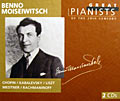 As aptly described by Bryan Crimp, he had a thoughtful, natural vibrancy, "brought classical elegance to the romantic repertoire and romantic warmth to the classical repertoire," and his playing seemed as natural as breathing. His Chopin was rarified and dreamy but, as Michael Steinberg concedes in his notes, perhaps a bit too gentle at times - magic and appropriate in the sedate Nocturnes but less satisfying when attenuating the undercurrent of anxiety in the Ballades and Scherzos which can seem one-dimensional. Nearly all of these recordings came late in his career, culimating in gracious but flaccid 1956 Rachmaninoff Concerto # 2 with Hugo Ringold conducting the Philharmonia that completely misses the sense of structure so important to the composer, who apparently considered Moiseiwitsch to be a superb interpreter of his works. An intriguing hint of better, earlier times comes with a 1939 Mendelssohn Midsummer Night's Dream Scherzo and a 1941 Liszt "La Leggierezza" Etude, in which the playing is far more animated and nuanced (despite blurry transfers). Indeed, a collection of 1940s recordings on APR 7005 provides a whole different side, including well-characterized episodes of Mussorgsky's Pictures at an Exhibition, a scintillating Weber Invitation to the Dance, and Liszt's arrangement of the Tannhauser Overture in which, as Crimp notes, with an extraordinary density of notes he nearly achieves the impossible task of conveying the scope and might of Wagner's orchestration on a two-handed keyboard. Perhaps of greatest interest here are the Kabalevsly Sonata # 3 and the Medtner Sonata in g minor, the latter in what appears to be its only recording - not among the greatest of masterworks, perhaps, but convincingly played and certainly worth hearing. As aptly described by Bryan Crimp, he had a thoughtful, natural vibrancy, "brought classical elegance to the romantic repertoire and romantic warmth to the classical repertoire," and his playing seemed as natural as breathing. His Chopin was rarified and dreamy but, as Michael Steinberg concedes in his notes, perhaps a bit too gentle at times - magic and appropriate in the sedate Nocturnes but less satisfying when attenuating the undercurrent of anxiety in the Ballades and Scherzos which can seem one-dimensional. Nearly all of these recordings came late in his career, culimating in gracious but flaccid 1956 Rachmaninoff Concerto # 2 with Hugo Ringold conducting the Philharmonia that completely misses the sense of structure so important to the composer, who apparently considered Moiseiwitsch to be a superb interpreter of his works. An intriguing hint of better, earlier times comes with a 1939 Mendelssohn Midsummer Night's Dream Scherzo and a 1941 Liszt "La Leggierezza" Etude, in which the playing is far more animated and nuanced (despite blurry transfers). Indeed, a collection of 1940s recordings on APR 7005 provides a whole different side, including well-characterized episodes of Mussorgsky's Pictures at an Exhibition, a scintillating Weber Invitation to the Dance, and Liszt's arrangement of the Tannhauser Overture in which, as Crimp notes, with an extraordinary density of notes he nearly achieves the impossible task of conveying the scope and might of Wagner's orchestration on a two-handed keyboard. Perhaps of greatest interest here are the Kabalevsly Sonata # 3 and the Medtner Sonata in g minor, the latter in what appears to be its only recording - not among the greatest of masterworks, perhaps, but convincingly played and certainly worth hearing.
- Ivan Moravec (b. 1930) - It’s a fitting coincidence that most of Moravec’s recordings were made for the Connoisseur Society label, as his art was subtle and deeply colorful, aimed more for sophisticates than the masses.
 He once summarized his career as a search for beauty, inspired by the vast quality of tone of the human voice. He was so sensitive to an evenness of touch and timbre on the pianos he played that he carried a set of tools to concerts and occasionally insisted upon making his own adjustments before performing. His poetic playing is often compared to Cortot’s, but even allowing for the differences in recording quality, the sheer sound he produced is incomparable. The notes, by Donald Minaldi, sum it up well: “a sonority so perfectly graded and balanced, replete with a unique smoothness and prismatic sheen.” Ironically, his technique may have been due to a spinal injury he suffered, which forced him to rely on the weight of his arms rather than his fingers. Half this collection is Chopin, where Moravec constantly amazes – the sheer range and depth of his monumental Barcarolle is truly awesome. His mastery of Debussy (the Images and Pour le piano) and Ravel (the Sonatine) are to be expected, but perhaps the greatest surprise is the way he demands attention for the unbearably boring Franck Prelude, choral et fugue, from the remarkable variety with which he renders the repetitive opening chords to the astounding perfection of his arpeggiations of the chorale. He once summarized his career as a search for beauty, inspired by the vast quality of tone of the human voice. He was so sensitive to an evenness of touch and timbre on the pianos he played that he carried a set of tools to concerts and occasionally insisted upon making his own adjustments before performing. His poetic playing is often compared to Cortot’s, but even allowing for the differences in recording quality, the sheer sound he produced is incomparable. The notes, by Donald Minaldi, sum it up well: “a sonority so perfectly graded and balanced, replete with a unique smoothness and prismatic sheen.” Ironically, his technique may have been due to a spinal injury he suffered, which forced him to rely on the weight of his arms rather than his fingers. Half this collection is Chopin, where Moravec constantly amazes – the sheer range and depth of his monumental Barcarolle is truly awesome. His mastery of Debussy (the Images and Pour le piano) and Ravel (the Sonatine) are to be expected, but perhaps the greatest surprise is the way he demands attention for the unbearably boring Franck Prelude, choral et fugue, from the remarkable variety with which he renders the repetitive opening chords to the astounding perfection of his arpeggiations of the chorale.
- John Odgen (1937 - 1989), volume 1 - This volume has the most painfully honest liner notes. Picture this: you've just spent $24 plus tax because you were attracted by the unusual
 repertoire in which Ogden specialized. Tired of multiple versions of the standard Chopin, Mozart, Liszt repertoire, you're eagerly anticipating your first hearing of the obscure Alkan Concerto for Piano Alone, which occupies most of the first disc and which the producers must have singled out from the Ogden discography for good reason. To enhance your enjoyment, you turn to the program notes for some insight into the delightful surprise that surely awaits. And what do you find? Well, not only do the notes disdain the piece as "disappointingly ordinary" but they then proceed to trash Ogden's performance as inferior to the competition ("… the finer spirit of the piece conceivably eluded him…") and conclude without disapproval that the LP was quickly deleted. OK -- let's give the writer an "A" for honesty. But really, guys, if the performance is all that dreadful, what's it doing here? repertoire in which Ogden specialized. Tired of multiple versions of the standard Chopin, Mozart, Liszt repertoire, you're eagerly anticipating your first hearing of the obscure Alkan Concerto for Piano Alone, which occupies most of the first disc and which the producers must have singled out from the Ogden discography for good reason. To enhance your enjoyment, you turn to the program notes for some insight into the delightful surprise that surely awaits. And what do you find? Well, not only do the notes disdain the piece as "disappointingly ordinary" but they then proceed to trash Ogden's performance as inferior to the competition ("… the finer spirit of the piece conceivably eluded him…") and conclude without disapproval that the LP was quickly deleted. OK -- let's give the writer an "A" for honesty. But really, guys, if the performance is all that dreadful, what's it doing here?
- John Ogden, volume 2 - Known for his love and advocacy of unusual repertoire (to which his first volume is devoted), Ogden's huge technique, phenomenal stamina,
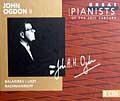 blazing commitment and vast emotional range, coupled with his probing intellect and sense of structure, were a natural fit for Liszt, to which one disc is devoted. The other disc, though, is even more wondrous - 70 minutes of Rachmaninoff miniatures, including the complete Op. 33 and Op. 39 Etudes-Tableaux. Usually relegated to encores or savored singly, these pieces emerge as a compelling cycle, with a cumulative effect abetted by Ogden's marvelous integration of the ebb and flow of their power and diffidence. The CD concludes with Ogden's stunning performance of Balakirev's fearsome Islamey, recorded live at the 1962 Moscow Tchaikovsky Competition, which floored the judges and netted Ogden a first prize (shared with Ashkenazy). blazing commitment and vast emotional range, coupled with his probing intellect and sense of structure, were a natural fit for Liszt, to which one disc is devoted. The other disc, though, is even more wondrous - 70 minutes of Rachmaninoff miniatures, including the complete Op. 33 and Op. 39 Etudes-Tableaux. Usually relegated to encores or savored singly, these pieces emerge as a compelling cycle, with a cumulative effect abetted by Ogden's marvelous integration of the ebb and flow of their power and diffidence. The CD concludes with Ogden's stunning performance of Balakirev's fearsome Islamey, recorded live at the 1962 Moscow Tchaikovsky Competition, which floored the judges and netted Ogden a first prize (shared with Ashkenazy).
- Ignacy Jan Paderewski (1860 - 1941) - Born in 1860, Paderewski is entitled to instant respect for being the oldest pianist represented in this series, but despite his legendary status his recordings have not worn well.
 The liner notes barely mention them, perhaps in keeping with the generally low critical esteem that consigns them to little more than grudging historical acknowledgement. According to conventional wisdom, Paderewski was caught between the primitive recording technique of his early discs, when he was still in his prime, and better-sounding electrical remakes after his skill had sadly deteriorated. For the most part, that’s true, as is heard by comparing his gossamer 1912 Liszt “La Campanella” (recorded in the acoustical process and included here) with its far cruder 1927 electrical remake. Yet, his playing on a 1917 Chopin “Butterfly” Etude is wooden, while a 1928 “Raindrop” Etude is exquisite, his famed color and delicacy in full display. Indeed, some of his earliest acousticals sound surprisingly good. If any generalization is validated by his 100-plus records, it might be that while full-bore sections tend to be bangy, quirky and rhythmically slack, his quieter moments often are astoundingly beautiful, especially in Chopin and Liszt – his discs of the Chopin Berceuse and the Liszt “La Leggierezza” remain utterly spellbinding. And speaking of the respect he is due, Paderewski was known as much for his passionate oratory and diplomatic advocacy for Poland as for his pianism, and so his Chopin must be valued as presumptively valid – if his recordings of the famous “Military” Polonaise seem far more rigid and formal than we are accustomed, their authenticity is beyond challenge. And speaking of authenticity, he exemplifies the mid-19th century practice of separating the hands; thus, in the Nocturne in E-flat, Op. 9 # 2, the right-hand constantly lags the left, a curious effect nowadays, but highly expressive. While largely succeeding in attenuating surface noise, the transfers here are dull, chopping off both highs and, curiously, lows compared to the far more realistic piano sound on Pearl compilations. The selections among his records are astute, and there’s little overlap with the three volumes of Pearl’s fine “The Art of Paderewski,” which eschew the Chopin that forms the bulk of this collection for his equally fascinating Haydn, Beethoven and Debussy, plus four self-penned pieces that put his magnificent talent on full display. The liner notes barely mention them, perhaps in keeping with the generally low critical esteem that consigns them to little more than grudging historical acknowledgement. According to conventional wisdom, Paderewski was caught between the primitive recording technique of his early discs, when he was still in his prime, and better-sounding electrical remakes after his skill had sadly deteriorated. For the most part, that’s true, as is heard by comparing his gossamer 1912 Liszt “La Campanella” (recorded in the acoustical process and included here) with its far cruder 1927 electrical remake. Yet, his playing on a 1917 Chopin “Butterfly” Etude is wooden, while a 1928 “Raindrop” Etude is exquisite, his famed color and delicacy in full display. Indeed, some of his earliest acousticals sound surprisingly good. If any generalization is validated by his 100-plus records, it might be that while full-bore sections tend to be bangy, quirky and rhythmically slack, his quieter moments often are astoundingly beautiful, especially in Chopin and Liszt – his discs of the Chopin Berceuse and the Liszt “La Leggierezza” remain utterly spellbinding. And speaking of the respect he is due, Paderewski was known as much for his passionate oratory and diplomatic advocacy for Poland as for his pianism, and so his Chopin must be valued as presumptively valid – if his recordings of the famous “Military” Polonaise seem far more rigid and formal than we are accustomed, their authenticity is beyond challenge. And speaking of authenticity, he exemplifies the mid-19th century practice of separating the hands; thus, in the Nocturne in E-flat, Op. 9 # 2, the right-hand constantly lags the left, a curious effect nowadays, but highly expressive. While largely succeeding in attenuating surface noise, the transfers here are dull, chopping off both highs and, curiously, lows compared to the far more realistic piano sound on Pearl compilations. The selections among his records are astute, and there’s little overlap with the three volumes of Pearl’s fine “The Art of Paderewski,” which eschew the Chopin that forms the bulk of this collection for his equally fascinating Haydn, Beethoven and Debussy, plus four self-penned pieces that put his magnificent talent on full display.
- Maria Joao Pires (b. 1944) - With an exquisite touch, every phrase is carefully inflected and alive with care and thought, yielding interpretations that
 manage to be deeply personal without becoming idiosyncratic, but rather reflect deep thought and consideration of how to present the musical essence. Over half this collection is devoted to four Mozart Sonatas, ranging from the deceptively simple K. 545 through the exotic "Turkish" K. 331 to the profound K. 333; all emerge full-blooded and adventurous, yet duly respectful of the composer's sensibilities, more akin to the youthful upstart of "Amadeus" than the gentle, dignified patriarch of classicism we have often come to accept and expect. The same qualities infuse the brief but startling cadenza of the Concerto # 14, with Abbado providing a nice orchestral foil. Three Chopin Nocturnes are restless, seeking something deeper than the peaceful meditations of Rubinstein and others. manage to be deeply personal without becoming idiosyncratic, but rather reflect deep thought and consideration of how to present the musical essence. Over half this collection is devoted to four Mozart Sonatas, ranging from the deceptively simple K. 545 through the exotic "Turkish" K. 331 to the profound K. 333; all emerge full-blooded and adventurous, yet duly respectful of the composer's sensibilities, more akin to the youthful upstart of "Amadeus" than the gentle, dignified patriarch of classicism we have often come to accept and expect. The same qualities infuse the brief but startling cadenza of the Concerto # 14, with Abbado providing a nice orchestral foil. Three Chopin Nocturnes are restless, seeking something deeper than the peaceful meditations of Rubinstein and others.
- Mikhail Pletnev (b. 1957) - Like Ashkenazy, Barenboim and Previn, Pletnev’s superb pianism may well become eclipsed by his formidable conducting career.
 Yet, while its vast resources provide more variety and power, the need to coordinate a hundred players tends to impose limits on interpretive impulse in which a soloist is free to indulge. Thus, while the Tchaikovsky symphonies Pletnev has led are rooted in a traditional approach, he faces no such constraints in the Tchaikovsky solo pieces to which this volume is largely devoted. A point of departure is the Piano Concerto # 2 (with Vladimir Fedosoyev and the Philharmonia), in which Pletnev overcomes the longeurs of the andante with an energized gallop of the allegro con fuoco finale, just as a good dessert erases memory of a mediocre entrée. Sorry, but I’ve never warmed (so to speak) to the alleged delights of the Tchaikovsky Seasons and not even Pletnev can mitigate the effect of so much vapid fluff that lacks the visceral emotional grip and melodic inspiration of prime Tchaikovsky. Indeed, the earnest, convincing performances of three early piano miniatures fare far better. The prizes here are Pletnev’s own suites from the Nutcracker and Swan Lake. The former opts for variety by omitting the overture, two dances and waltz of the usual suite to make room for the exquisite intermezzo and pas de deux. Both translate the familiar scores into brilliantly effective and highly imaginative piano writing. While preserving the fundamental balletic thrust, there’s no pretense of dancing – the rhythms, while compelling, are far too impulsive and the dynamics too extreme to survive the stage noises of a performance. It’s a unique transformation that conveys the essence of the source while engaging the essential nature of the piano and reflects the handiwork of a master musician. Yet, while its vast resources provide more variety and power, the need to coordinate a hundred players tends to impose limits on interpretive impulse in which a soloist is free to indulge. Thus, while the Tchaikovsky symphonies Pletnev has led are rooted in a traditional approach, he faces no such constraints in the Tchaikovsky solo pieces to which this volume is largely devoted. A point of departure is the Piano Concerto # 2 (with Vladimir Fedosoyev and the Philharmonia), in which Pletnev overcomes the longeurs of the andante with an energized gallop of the allegro con fuoco finale, just as a good dessert erases memory of a mediocre entrée. Sorry, but I’ve never warmed (so to speak) to the alleged delights of the Tchaikovsky Seasons and not even Pletnev can mitigate the effect of so much vapid fluff that lacks the visceral emotional grip and melodic inspiration of prime Tchaikovsky. Indeed, the earnest, convincing performances of three early piano miniatures fare far better. The prizes here are Pletnev’s own suites from the Nutcracker and Swan Lake. The former opts for variety by omitting the overture, two dances and waltz of the usual suite to make room for the exquisite intermezzo and pas de deux. Both translate the familiar scores into brilliantly effective and highly imaginative piano writing. While preserving the fundamental balletic thrust, there’s no pretense of dancing – the rhythms, while compelling, are far too impulsive and the dynamics too extreme to survive the stage noises of a performance. It’s a unique transformation that conveys the essence of the source while engaging the essential nature of the piano and reflects the handiwork of a master musician.
- Andre Previn (b. 1929) - It’s remarkable how many pop and especially jazz musicians had classical training, but far rarer for a credible classical musician to have emerged from the ranks of pop.
 True, Linda Ronstadt tried opera, Elvis Costello worked with the Brodsky Quartet, Keith Jarrett plays Bach and Paul McCartney dabbled in classical composition (albeit of the light-weight crossover variety), but Previn’s musical journey was nearly unique. He gained fame and great success as a jazz pianist and movie arranger (he was nominated for 13 Academy Awards and won four in a streak of seven years for adapting the scores to My Fair Lady, Gigi, Porgy and Bess and Irma La Douce) before emerging as a serious pianist and conductor. Half of this collection is given to Gershwin, who, like Previn, straddled both pop and serious worlds. Previn both plays and conducts the Concerto in F and Rhapsody in Blue, but the orchestral portions are surprisingly stiff, his solos more suited to the lyrical sections. Piano and bass arrangements of seven Gershwin songs provide a more natural fit, as Previn’s gently innovative improvisations recall the cool, laid-back style of his early career and invite the interpretive improvisatory freedom we would tend to associate with a jazz background. Typical is his free treatment of “I Got Rhythm,” in which the melody is so fragmented that the distinctive motifs of both verse and chorus are barely discernable. The other CD displays Previn’s versatility. The Mozart Piano Concerto # 17, which he also conducts, proves he can settle into a serious groove. The Shostakovich Concerto for Piano, Trumpet and Strings displays a far more galvanic style when paired with a dynamic conductor like Leonard Bernstein. Finally, there’s a half-hour of Poulenc, including the Trois pièces and the Suite française – light-weight but pleasant, and enlivened by Previn’s attentive moderation. True, Linda Ronstadt tried opera, Elvis Costello worked with the Brodsky Quartet, Keith Jarrett plays Bach and Paul McCartney dabbled in classical composition (albeit of the light-weight crossover variety), but Previn’s musical journey was nearly unique. He gained fame and great success as a jazz pianist and movie arranger (he was nominated for 13 Academy Awards and won four in a streak of seven years for adapting the scores to My Fair Lady, Gigi, Porgy and Bess and Irma La Douce) before emerging as a serious pianist and conductor. Half of this collection is given to Gershwin, who, like Previn, straddled both pop and serious worlds. Previn both plays and conducts the Concerto in F and Rhapsody in Blue, but the orchestral portions are surprisingly stiff, his solos more suited to the lyrical sections. Piano and bass arrangements of seven Gershwin songs provide a more natural fit, as Previn’s gently innovative improvisations recall the cool, laid-back style of his early career and invite the interpretive improvisatory freedom we would tend to associate with a jazz background. Typical is his free treatment of “I Got Rhythm,” in which the melody is so fragmented that the distinctive motifs of both verse and chorus are barely discernable. The other CD displays Previn’s versatility. The Mozart Piano Concerto # 17, which he also conducts, proves he can settle into a serious groove. The Shostakovich Concerto for Piano, Trumpet and Strings displays a far more galvanic style when paired with a dynamic conductor like Leonard Bernstein. Finally, there’s a half-hour of Poulenc, including the Trois pièces and the Suite française – light-weight but pleasant, and enlivened by Previn’s attentive moderation.
- Sergei Rachmaninoff (1873 - 1943) - Of all those represented here, Rachmaninoff surely had the most curious route to fame as a pianist. Initially, propelled by the sensational popularity of his early Prelude in c-# minor,
 he followed in the footsteps of the great composer-pianists of an earlier time. He then turned to conducting. Exiled to America after the Russian Revolution and in need of income, he launched a new career as a soloist at an age (44) when most of his peers were easing toward retirement. Even so, he soon gained a reputation, as described by Harold Schonberg, for colossal technique, which he used in the service of logical organization and verile rhythm that ennobled everything he played. To that I would add that he had a direct, earnest quality, shorn of humor - deeply serious, with each gesture committed toward conveying the overall meaning. Unfortunately, the vast majority of his recordings are of short encores and miniatures, including many of his own compositions and arrangements which, no matter how well performed, are still mundane and can seem tiresome when heard together as on the second CD here. Reportedly, a 1941 project never materialized, and so all we have of major solo works is a 1929 Schumann Carnaval (which, while he strongly characterizes each component, is still just a collection of short pieces) and a hugely powerful 1930 Chopin Sonata # 2, with a funeral march of astounding terror. Indeed, of the short pieces, his Chopin is perhaps the most memorable, with sections of boldly differentiated textures, tempos and phrasing. An essential supplement to his solo work heard here are his own four piano concertos and the Rhapsody on a Theme of Paganini, with the Philadelphia Orchestra under Stokowski and Ormandy, all incomparably played with firm and dry vitality, and his 1928 Beethoven, Schubert and Grieg sonatas with Fritz Kreisler, a fascinating blend in which each artist blends his temperament to meet the other. he followed in the footsteps of the great composer-pianists of an earlier time. He then turned to conducting. Exiled to America after the Russian Revolution and in need of income, he launched a new career as a soloist at an age (44) when most of his peers were easing toward retirement. Even so, he soon gained a reputation, as described by Harold Schonberg, for colossal technique, which he used in the service of logical organization and verile rhythm that ennobled everything he played. To that I would add that he had a direct, earnest quality, shorn of humor - deeply serious, with each gesture committed toward conveying the overall meaning. Unfortunately, the vast majority of his recordings are of short encores and miniatures, including many of his own compositions and arrangements which, no matter how well performed, are still mundane and can seem tiresome when heard together as on the second CD here. Reportedly, a 1941 project never materialized, and so all we have of major solo works is a 1929 Schumann Carnaval (which, while he strongly characterizes each component, is still just a collection of short pieces) and a hugely powerful 1930 Chopin Sonata # 2, with a funeral march of astounding terror. Indeed, of the short pieces, his Chopin is perhaps the most memorable, with sections of boldly differentiated textures, tempos and phrasing. An essential supplement to his solo work heard here are his own four piano concertos and the Rhapsody on a Theme of Paganini, with the Philadelphia Orchestra under Stokowski and Ormandy, all incomparably played with firm and dry vitality, and his 1928 Beethoven, Schubert and Grieg sonatas with Fritz Kreisler, a fascinating blend in which each artist blends his temperament to meet the other.
- Sviatoslav Richter (1915 - 1997), volume 3 - The first of Richter's three volumes featured his celebrated 1958 Sofia concert and Prokofiev, while the second comprised
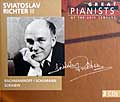 Beethoven sonatas. This, his final volume, begins with a quirky 1959 Rachmaninov Second with Wislocki and the Warsaw Philharmonic that lurches between moods rather than integrates them, as nearly all other performances aim to do. Piano and orchestra often diverge; although the liner notes claim that this is a deliberate attempt to suggest improvisation, it sounds far less convincing and just sloppy. The rest of this collection, though, presenting six Rachmaninov Preludes, 12 Scriabin Etudes and Schumann's Waldszenen, Fantasiestucke, Op. 12, Fantasie in C and Toccata, is prime Richter - assertive, direct, richly satisfying, going right to the heart of the music - in a word, classic. Beethoven sonatas. This, his final volume, begins with a quirky 1959 Rachmaninov Second with Wislocki and the Warsaw Philharmonic that lurches between moods rather than integrates them, as nearly all other performances aim to do. Piano and orchestra often diverge; although the liner notes claim that this is a deliberate attempt to suggest improvisation, it sounds far less convincing and just sloppy. The rest of this collection, though, presenting six Rachmaninov Preludes, 12 Scriabin Etudes and Schumann's Waldszenen, Fantasiestucke, Op. 12, Fantasie in C and Toccata, is prime Richter - assertive, direct, richly satisfying, going right to the heart of the music - in a word, classic.
- Artur Schnabel (1882 - 1951) - While he also championed the then-neglected solo music of Mozart and Schubert, Schnabel is most remembered for his Beethoven,
 the exclusive focus of this volume. Nowadays the Beethoven "32" are a fundamental canon of piano music, which any self-respecting artist is expected to master and record. Yet, when Schnabel was commissioned to create the very first complete set in 1932, the project was deemed so risky that it was undertaken as a limited edition of prepaid subscriptions. Ever since, it has transcended its historical importance to serve as a landmark of triumphant artistry, and has remained in print, from public 78 editions through LPs and CDs. Although hailed as an intellectual, Schnabel's playing isn't at all a dry or academic exercise; rather, he outlines the structures with magnificent vigor and vitality. His stormy 1933 "Waldstein" Sonata, which launches this volume, and the wide-ranging 1937 "Diabelli" Variations, serve as a fabulous introduction to Schnabel's unique ability to channel the spirit and meaning of Beethoven without intruding his own personality (which was considerable, evidenced by his 1935 publication of an edition of the Beethoven Sonata scores, replete with deeply personal yet detailed scholarly annotations as to tempos, phrasing and fingering). Also included are previously unpublished 1942 remakes of the Sonatas # 30 and 32, fascinating supplements to the earlier set; although the interpretive differences are very slight, the improved recording affords a better glimpse into Schnabel's tone, which has provoked much variation among transfer engineers; the "Waldstein" here is far muddier than the vibrant version on Naxos, which, sounding closer to the 1942 remakes, seems more authentic). Schnabel also cut a pioneering set of the Beethoven Piano Concertos with Sir Malcolm Sargent conducting the London Philharmonic, of which we get the 1933 Fourth. The sound is decent and conveys a greater sense of classical balance and finesse than would Schnabel's more intense 1942 Stock/Chicago or slightly crude 1946 Dobrowen/Philharmonia remakes. (Overlooked by the notes is a fragmentary 1947 performance with Izler Solomon and the Columbus Symphony on Pearl that captures a rare glimpse of Schnabel in concert and features a meltingly gorgeous Andante.) the exclusive focus of this volume. Nowadays the Beethoven "32" are a fundamental canon of piano music, which any self-respecting artist is expected to master and record. Yet, when Schnabel was commissioned to create the very first complete set in 1932, the project was deemed so risky that it was undertaken as a limited edition of prepaid subscriptions. Ever since, it has transcended its historical importance to serve as a landmark of triumphant artistry, and has remained in print, from public 78 editions through LPs and CDs. Although hailed as an intellectual, Schnabel's playing isn't at all a dry or academic exercise; rather, he outlines the structures with magnificent vigor and vitality. His stormy 1933 "Waldstein" Sonata, which launches this volume, and the wide-ranging 1937 "Diabelli" Variations, serve as a fabulous introduction to Schnabel's unique ability to channel the spirit and meaning of Beethoven without intruding his own personality (which was considerable, evidenced by his 1935 publication of an edition of the Beethoven Sonata scores, replete with deeply personal yet detailed scholarly annotations as to tempos, phrasing and fingering). Also included are previously unpublished 1942 remakes of the Sonatas # 30 and 32, fascinating supplements to the earlier set; although the interpretive differences are very slight, the improved recording affords a better glimpse into Schnabel's tone, which has provoked much variation among transfer engineers; the "Waldstein" here is far muddier than the vibrant version on Naxos, which, sounding closer to the 1942 remakes, seems more authentic). Schnabel also cut a pioneering set of the Beethoven Piano Concertos with Sir Malcolm Sargent conducting the London Philharmonic, of which we get the 1933 Fourth. The sound is decent and conveys a greater sense of classical balance and finesse than would Schnabel's more intense 1942 Stock/Chicago or slightly crude 1946 Dobrowen/Philharmonia remakes. (Overlooked by the notes is a fragmentary 1947 performance with Izler Solomon and the Columbus Symphony on Pearl that captures a rare glimpse of Schnabel in concert and features a meltingly gorgeous Andante.)
- Rudolph Serkin (1903 - 1991) - Like the Glenn Gould volume noted above, this is far more a reflection of licensing problems than a tribute to a great artist.
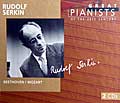 The first hint of trouble comes before you even remove the shrink-wrap - the back cover listing of contributing labels omits Sony, the successor to Columbia for which Serkin recorded exclusively during his entire mature career. In lieu of any of his memorable classics, we’re stuck instead with two early EMI recordings before his unique fire was fully kindled and four very late DG Mozart piano concerti after it was nearly extinguished. Thus, we are left to only infer his rigorous and powerful Beethoven from his first and somewhat tentative 1936 record of the “Appassionata” Sonata rather than the sweeping early stereo version that was popularized through dozens of LP compilations. Similarly, despite sparkling sound and sympathetic accompaniment by Abbado and the London Symphony, we can only glean from these deferential accounts of his ‘eighties tracings of Serkin’s precise but passionate Mozart collaborations with Szell and Schneider. Alas, by including four valedictory concertos when one would have sufficed, Serkin’s famous Schubert, Mendelssohn and Brahms are excluded altogether. The final delusion comes on the last page, where a list of other available Serkin recordings mentions only those few on EMI and DG, ignoring all the more consequential ones readily available on Sony, several of which are on their Essential Classics budget line. In sum, this is a bizarre collection that sidesteps and ultimately distorts the prime career of one of the greatest and most influential pianists of the century. The first hint of trouble comes before you even remove the shrink-wrap - the back cover listing of contributing labels omits Sony, the successor to Columbia for which Serkin recorded exclusively during his entire mature career. In lieu of any of his memorable classics, we’re stuck instead with two early EMI recordings before his unique fire was fully kindled and four very late DG Mozart piano concerti after it was nearly extinguished. Thus, we are left to only infer his rigorous and powerful Beethoven from his first and somewhat tentative 1936 record of the “Appassionata” Sonata rather than the sweeping early stereo version that was popularized through dozens of LP compilations. Similarly, despite sparkling sound and sympathetic accompaniment by Abbado and the London Symphony, we can only glean from these deferential accounts of his ‘eighties tracings of Serkin’s precise but passionate Mozart collaborations with Szell and Schneider. Alas, by including four valedictory concertos when one would have sufficed, Serkin’s famous Schubert, Mendelssohn and Brahms are excluded altogether. The final delusion comes on the last page, where a list of other available Serkin recordings mentions only those few on EMI and DG, ignoring all the more consequential ones readily available on Sony, several of which are on their Essential Classics budget line. In sum, this is a bizarre collection that sidesteps and ultimately distorts the prime career of one of the greatest and most influential pianists of the century.
- Vladimir Sofronitsky (1901 - 1961) - An icon in his native Russia and hailed by such luminaries as Richter and Gilels as their master, Sofronitsky was barely known
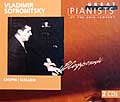 in the West, as his travels and fame were limited first by the Soviet regime and then by illness and addiction. A complete 1960 Moscow recital is available on Melodiya which displays more of the scope of his artistry from Mozart to Rachmaninov. This set, though, achieves a sharper focus by devoting an entire disc to each of his two favorite composers. Sofronitsky absorbed Chopin during studies in Warsaw; his mazurkas, in particular, startle with their sharp accents and bold rhythms - a bit crude, perhaps, but bursting with refreshing excitement. But Sofronitsky will be remembered above all for his Scriabin. Enthralled with this music from childhood exposure, he married the composer's daughter, performed on his piano and became a tireless advocate of his works. But more important than these biographical ties is the uncanny sense of artistic identification through which Sofronitsky projected Scriabin's bizarre music in a natural and throroughly convincing way - intensely atmospheric, powerful and emotionally involving. in the West, as his travels and fame were limited first by the Soviet regime and then by illness and addiction. A complete 1960 Moscow recital is available on Melodiya which displays more of the scope of his artistry from Mozart to Rachmaninov. This set, though, achieves a sharper focus by devoting an entire disc to each of his two favorite composers. Sofronitsky absorbed Chopin during studies in Warsaw; his mazurkas, in particular, startle with their sharp accents and bold rhythms - a bit crude, perhaps, but bursting with refreshing excitement. But Sofronitsky will be remembered above all for his Scriabin. Enthralled with this music from childhood exposure, he married the composer's daughter, performed on his piano and became a tireless advocate of his works. But more important than these biographical ties is the uncanny sense of artistic identification through which Sofronitsky projected Scriabin's bizarre music in a natural and throroughly convincing way - intensely atmospheric, powerful and emotionally involving.
- Solomon (1902 - 1988) - No, that's not a typo, but don't be duped by the name. You'd expect an artist using only a single one to be a flamboyant egotist,
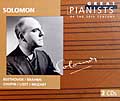 but Solomon's art was the precise opposite, harnessing polished virtuosity to the service of music. There's lots of excitement, but it's not from cutting loose but rather knowing that at any moment he could. Art, after all, is sublimation. Solomon's disciplined but vital intellect infuses the Beethoven "Hammerklavier" Sonata (which flows beautifully despite having been taped over 4 separate sessions), and especially its central adagio sostenuto (which at 22 minutes is very sostenuto indeed), making us hang on each shimmering note suspended in time. There's also a Brahms Handel Variations, classically reticent but with a full gamut of expression, a magnificent Bach/Liszt Prelude and Fugue in a minor, and wonderful Chopin and Liszt. A poignant addition is an August, 1956 Mozart Sonata in B flat, K. 333, Solomon's previously unpublished last solo recording before the stroke that prematurely ended the career of one of the true greats of our century. Incidentally, although all other volumes have the same notes translated into 3 languages, here the French set is different from the English/German ones. "Pure, but never austere," they say, and that just about sums up the wisdom of Solomon as well as anything. but Solomon's art was the precise opposite, harnessing polished virtuosity to the service of music. There's lots of excitement, but it's not from cutting loose but rather knowing that at any moment he could. Art, after all, is sublimation. Solomon's disciplined but vital intellect infuses the Beethoven "Hammerklavier" Sonata (which flows beautifully despite having been taped over 4 separate sessions), and especially its central adagio sostenuto (which at 22 minutes is very sostenuto indeed), making us hang on each shimmering note suspended in time. There's also a Brahms Handel Variations, classically reticent but with a full gamut of expression, a magnificent Bach/Liszt Prelude and Fugue in a minor, and wonderful Chopin and Liszt. A poignant addition is an August, 1956 Mozart Sonata in B flat, K. 333, Solomon's previously unpublished last solo recording before the stroke that prematurely ended the career of one of the true greats of our century. Incidentally, although all other volumes have the same notes translated into 3 languages, here the French set is different from the English/German ones. "Pure, but never austere," they say, and that just about sums up the wisdom of Solomon as well as anything.
- Rosalyn Tureck (b. 1914), volume 2 - Bach's Goldberg Variations is a throwback to a culture light-years removed from our present age of constant and immediate
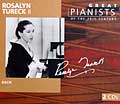 gratification. The same could be said for this rarefied, magisterial performance. Glenn Gould and Wanda Landowska, arguably the primary Bach specialists of our century, took between 39 and 51 minutes in their recordings, but Tureck allots 94! Only part of the difference arises from repeats; the rest lies in the deliberate unfolding of a multi-layered masterpiece whose marvels deserve and repay careful scrutiny. The wondrous result is that each variation serves not only as a brick in the overall structure and a stepping-stone toward the conclusion, but establishes its own identity and emerges as an experience unto itself. And when that breath-taking conclusion does arrive - an unadorned repeat of the simple wisp of a theme that began the piece and generated such a universe of creativity - it carries the added weight of an entire evening of development. Also included are equally fine readings of the Partita in b minor, BWV 831, the Italian Concerto and four duets, BMV 802-805. (The complete Partitas comprise Tureck's first volume.) This is unique and distinctive Bach playing, magnificent in its own right and a worthy complement to the legacies of Gould and Landowska. gratification. The same could be said for this rarefied, magisterial performance. Glenn Gould and Wanda Landowska, arguably the primary Bach specialists of our century, took between 39 and 51 minutes in their recordings, but Tureck allots 94! Only part of the difference arises from repeats; the rest lies in the deliberate unfolding of a multi-layered masterpiece whose marvels deserve and repay careful scrutiny. The wondrous result is that each variation serves not only as a brick in the overall structure and a stepping-stone toward the conclusion, but establishes its own identity and emerges as an experience unto itself. And when that breath-taking conclusion does arrive - an unadorned repeat of the simple wisp of a theme that began the piece and generated such a universe of creativity - it carries the added weight of an entire evening of development. Also included are equally fine readings of the Partita in b minor, BWV 831, the Italian Concerto and four duets, BMV 802-805. (The complete Partitas comprise Tureck's first volume.) This is unique and distinctive Bach playing, magnificent in its own right and a worthy complement to the legacies of Gould and Landowska.
- Mitsuko Uchida (b. 1948) - It’s somewhat surprising that so few internationally famous musicians hail from Japan, given that country’s passionate love of Western classical music.
 (Their inventors even designed the CD with a playing time sufficient to accommodate the Beethoven Ninth.) Among conductors there’s Seiji Ozawa, and among instrumentalists there’s Uchida, although she trained in Vienna and has lived in London her entire adult life. Uchida claims to have been drawn to Mozart simply because no one else was playing him in London, but surely she’s being modest or teasing, as the consistent brilliance of her recordings of his complete sonatas and concerti transcends expediency or commerce. Her Mozart gleams with purity, an effortless, relaxed aura enlivened with fascinating expressive touches, a simplicity that implies the most natural range of human feeling beneath a deceptively smooth surface. As sampled here, the Variations in G, KV 455 are a proud display of Mozart’s fertile invention, the Rondo in a minor, KV 511 lulls with smoothly shifting moods, the Adagio in b minor, KV 540 is gently fitful, and the Piano Concerto # 9 in E flat (“Jeunehomme”), joined by the English Chamber Orchestra conducted by Jeffrey Tate, evokes the elegance and tenderness of the lady for whom it was written. While Mozart forms the bulk of Uchida’s discography, the second disc is equally delightful. The complete set of Debussy Etudes, while played impeccably, transcend the formidable challenge of technique, beginning with the dry humor of the opening, and ranging through spritely mischief (“Pour les degrés chromatiques”), delirious arabesques (“Pour les huit doigts”), delicate rumination (“Pour les sonorités opposées”) and haunting atmosphere offset by spiky percussive effects (“Pour les accords”). The set concludes with Schoenberg’s Drei Klavierstüke, Op. 11, the only work specially recorded for the Great Pianists edition, which seems a natural extension of Debussy. Whether intentional or not, the juxtaposition serves to suggest that Schoenberg’s atonality, of which the Klavierstüke was a stepping-off point, was not only derived from German expressionism, but also heavily influenced by Debussy’s modal explorations, and perhaps even by the elegant simplicity of 18th century Mozart and the precise articulation demanded of his piano writing, all of which Uchida conveys with perfection. (Their inventors even designed the CD with a playing time sufficient to accommodate the Beethoven Ninth.) Among conductors there’s Seiji Ozawa, and among instrumentalists there’s Uchida, although she trained in Vienna and has lived in London her entire adult life. Uchida claims to have been drawn to Mozart simply because no one else was playing him in London, but surely she’s being modest or teasing, as the consistent brilliance of her recordings of his complete sonatas and concerti transcends expediency or commerce. Her Mozart gleams with purity, an effortless, relaxed aura enlivened with fascinating expressive touches, a simplicity that implies the most natural range of human feeling beneath a deceptively smooth surface. As sampled here, the Variations in G, KV 455 are a proud display of Mozart’s fertile invention, the Rondo in a minor, KV 511 lulls with smoothly shifting moods, the Adagio in b minor, KV 540 is gently fitful, and the Piano Concerto # 9 in E flat (“Jeunehomme”), joined by the English Chamber Orchestra conducted by Jeffrey Tate, evokes the elegance and tenderness of the lady for whom it was written. While Mozart forms the bulk of Uchida’s discography, the second disc is equally delightful. The complete set of Debussy Etudes, while played impeccably, transcend the formidable challenge of technique, beginning with the dry humor of the opening, and ranging through spritely mischief (“Pour les degrés chromatiques”), delirious arabesques (“Pour les huit doigts”), delicate rumination (“Pour les sonorités opposées”) and haunting atmosphere offset by spiky percussive effects (“Pour les accords”). The set concludes with Schoenberg’s Drei Klavierstüke, Op. 11, the only work specially recorded for the Great Pianists edition, which seems a natural extension of Debussy. Whether intentional or not, the juxtaposition serves to suggest that Schoenberg’s atonality, of which the Klavierstüke was a stepping-off point, was not only derived from German expressionism, but also heavily influenced by Debussy’s modal explorations, and perhaps even by the elegant simplicity of 18th century Mozart and the precise articulation demanded of his piano writing, all of which Uchida conveys with perfection.
- Maria Yudina (1899 - 1970) - I want to conclude on a huge upbeat. Until very recently, Maria Yudina (1899 - 1970), while a legend in Russia, was virually unknown in the West,
 and with good reason. She apparently was a dissident, both politically (she was one of the very few who apparently told off Stalin and survived) and artistically (she was a modernist in an artistically reactionary cold-war Russia). Not surprisingly, while others were allowed to concertize, travel and teach as a reward for their loyalty, her career sputtered through constant dismissals, bans and repression. Her only other CD, part of the ten-volume Melodiya Russian Piano School set, is of modern stuff, dutifully played but without fireworks. The prospect of her "Great Pianists" set featuring Bach's Goldberg Variations and Beethoven's Diabelli and Eroica Variations seemed pretty deadly. Here, I have to admit to an embarrassing personal prejudice - although these works are generally considered the apogee of the variation format (in which a simple melody passes through all sorts of permutations for an hour or so), they barely keep me awake. (Perhaps that's fitting, since legend has it that the Bach was commissioned by its patron to cure his insomnia.) Until I heard Yudina, that is. Wow! As Jimmy Durante (to whom she came to bear more than a passing resemblance) might have said: "Can that lady play the pianner!" Her playing is so devoid of frills or personal interpretive baggage, yet so full of conviction, so vivid, so utterly honest. I can't even imagine nodding off to such astoundingly verile work. and with good reason. She apparently was a dissident, both politically (she was one of the very few who apparently told off Stalin and survived) and artistically (she was a modernist in an artistically reactionary cold-war Russia). Not surprisingly, while others were allowed to concertize, travel and teach as a reward for their loyalty, her career sputtered through constant dismissals, bans and repression. Her only other CD, part of the ten-volume Melodiya Russian Piano School set, is of modern stuff, dutifully played but without fireworks. The prospect of her "Great Pianists" set featuring Bach's Goldberg Variations and Beethoven's Diabelli and Eroica Variations seemed pretty deadly. Here, I have to admit to an embarrassing personal prejudice - although these works are generally considered the apogee of the variation format (in which a simple melody passes through all sorts of permutations for an hour or so), they barely keep me awake. (Perhaps that's fitting, since legend has it that the Bach was commissioned by its patron to cure his insomnia.) Until I heard Yudina, that is. Wow! As Jimmy Durante (to whom she came to bear more than a passing resemblance) might have said: "Can that lady play the pianner!" Her playing is so devoid of frills or personal interpretive baggage, yet so full of conviction, so vivid, so utterly honest. I can't even imagine nodding off to such astoundingly verile work.
More than anything else, the Yudina set encouraged me to get many other volumes of the "Great Pianists of the 20th Century" edition in which at first I was only marginally interested. True, a few turned out to be duds, but more often than not there were delightful surprises. It's a tribute to the richness of music that no two listeners will ever agree as to a single list of the absolute "best" performances, and perhaps that's the ultimate significance of this Edition. No one will fully endorse the producer's selections, but there's some fabulous stuff from unexpected places that will deepen and enrich anyone's understanding and enjoyment of the huge body of piano recordings of the twentieth century.

Copyright 1999 and 2005 by Peter Gutmann
|